Take Me to the Recipes
Australian food is a vibrant and dynamic tapestry woven from the land’s vast geography and cultural diversity. Australia is on the world’s smallest continent and sixth-largest country by total area.
Its typical climate ranges from tropical in the north to temperate in the south. The scenery is a diverse mix of bustling cities, vast outback landscapes, picturesque beaches, and verdant rainforests.
Australia’s main industrial activities include mining-related exports, telecommunications, banking, and manufacturing, with a burgeoning food and wine scene that’s rapidly gaining global recognition. The population, around 25 million, is mainly urban along the coast.
Take Me to the Recipes
Australian Food – Key takeaways
- Australian cuisine reflects a fusion of indigenous traditions and diverse immigrant influences.
- Seafood, meat, and fresh produce are staples of Australian national dishes.
- Australian barbeque and ‘bush tucker’ are unique aspects of its food culture.
- Iconic Australian foods include Vegemite, meat pies, and lamingtons.
- Australia’s wine regions contribute significantly to its gastronomic reputation.
- Contemporary Australian cuisine incorporates a locavore philosophy, emphasizing local, seasonal ingredients.
Where is Australia?

Australia lies between the Pacific and Indian oceans. It is the largest island – and one of the largest countries – in the world. Its closest neighbours are New Zealand to the east and Papua New Guinea to the north

Index to the Contents
- Take Me to the Recipes
- More Articles
- 10 Fascinating Facts about Australia
- Australia’s History and the Effect It Has Had on the Cuisine
- How Australia‘s Climate and Geography Have Influenced the Cuisine
- Understanding the Essence of Australian Food
- Australian Culinary Traditions
- Exploring Australian Ingredients
- Mastering Australian Cuisine Cooking Techniques
- Traditional Australian Food
- Exploring Australian Street Food
- The Most Popular Australian Food Recipes
- What are the Health Implications of Australian Cuisine?
- Australia’s National Dish
- Australian Food – Great Recipes to Try at Home
- Conclusion
- Frequently Asked Questions
You may also Enjoy the Following Articles
- North and South American Cuisine – A Culinary Expedition
- European Cuisine: Savor the Continent’s Best Culinary Secrets!
- African Cuisine: Discover the Bold Flavors & Global Charm!
- Asian Cuisine Unlock its Secrets – Taste, Health & Global Influence!
- Oceania Cooking: A Culinary Journey Through the Pacific
- Australian Cuisine – A Delightful Taste Adventure
Savor iconic Australian Food Recipes – Click on each tantalizing picture to open up the Recipe

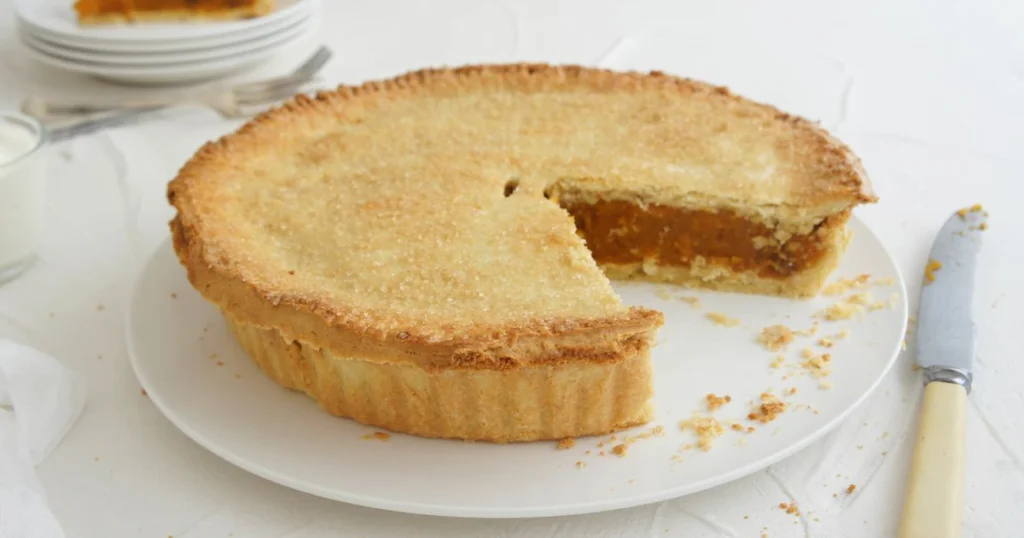



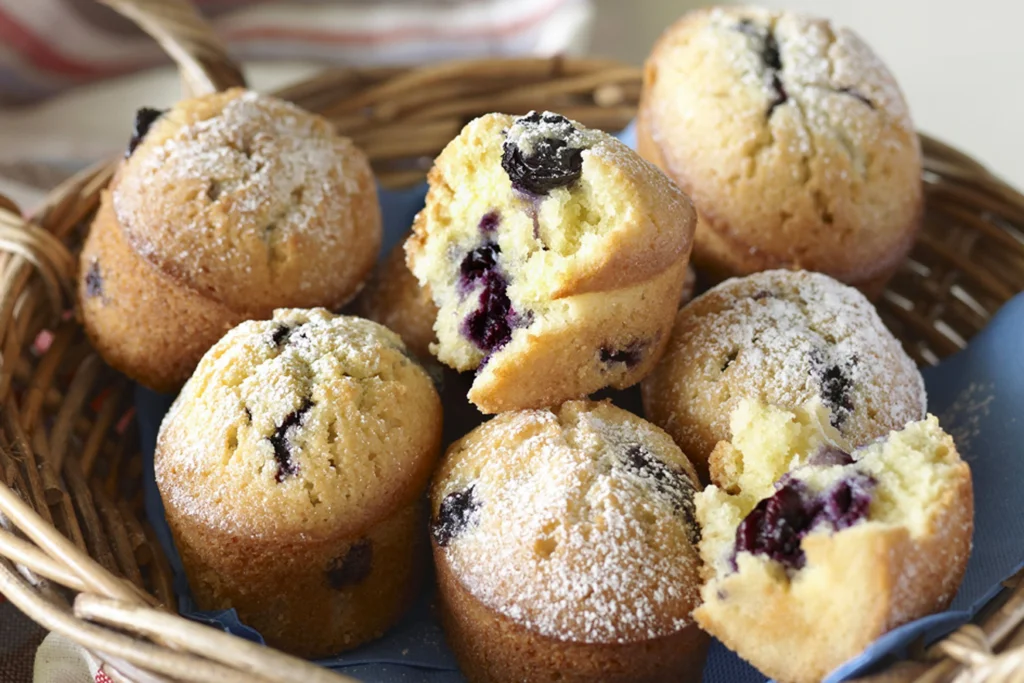


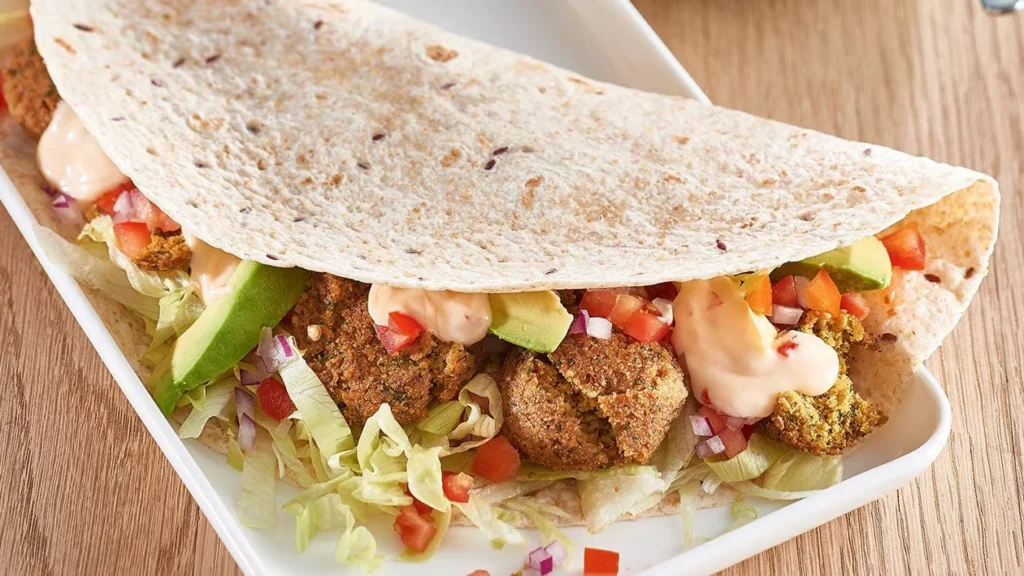


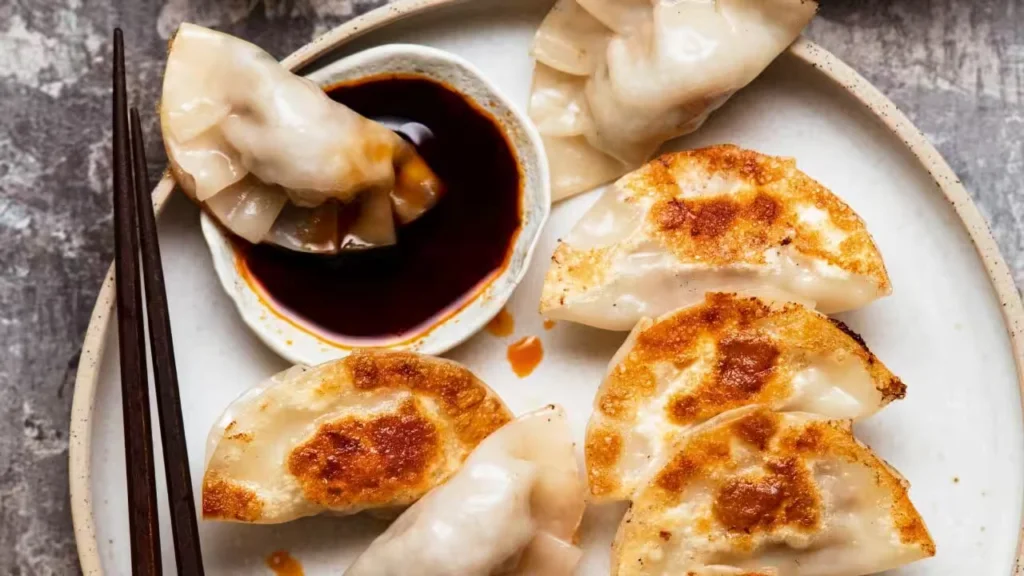



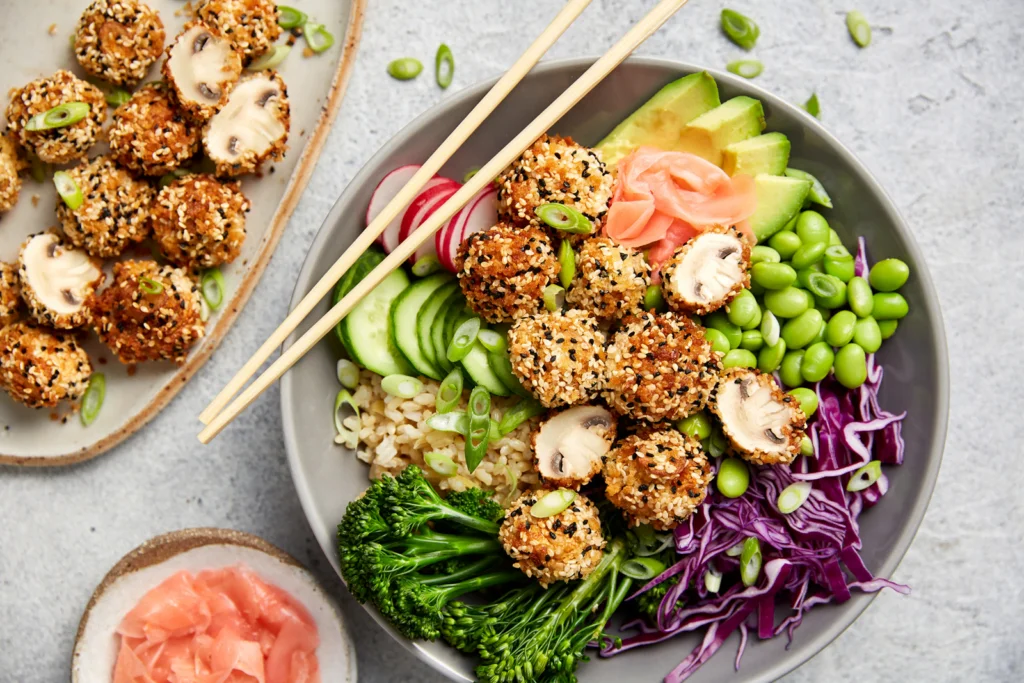


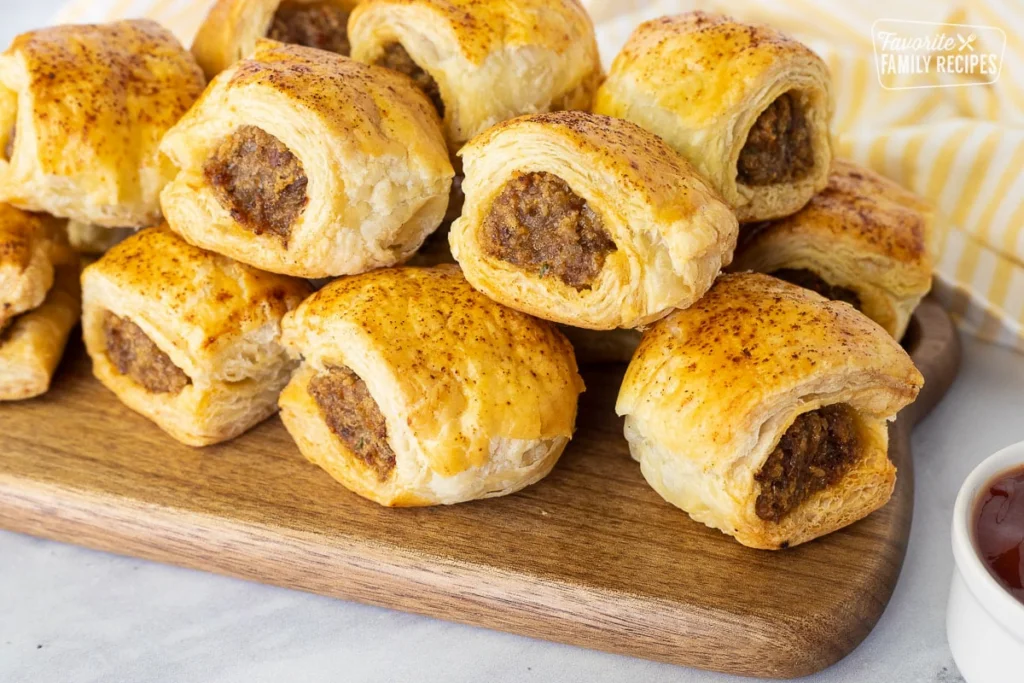

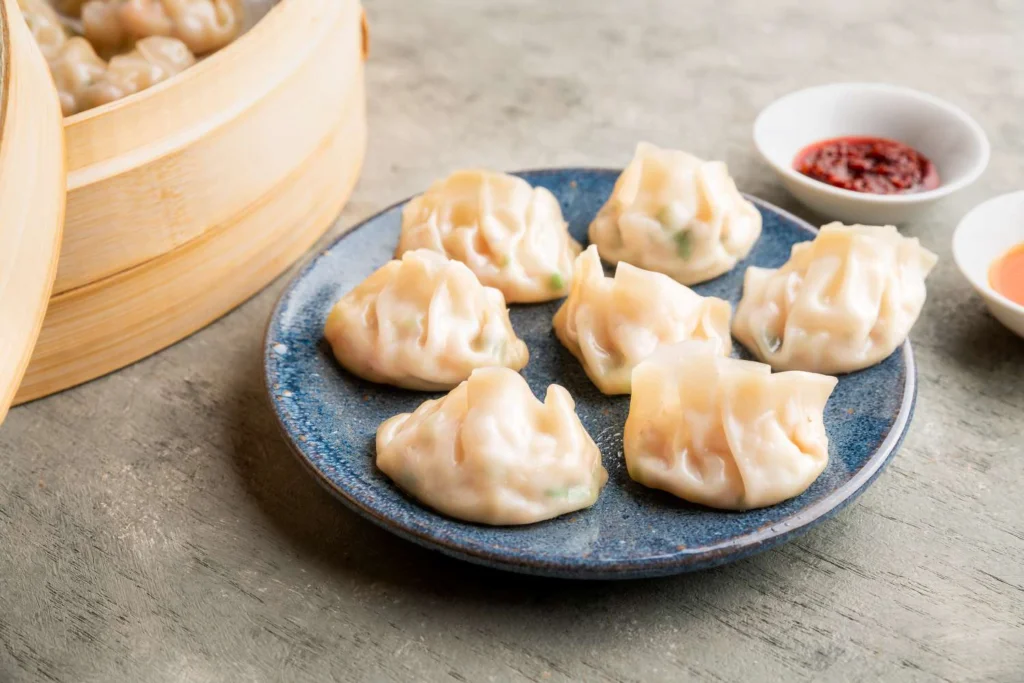
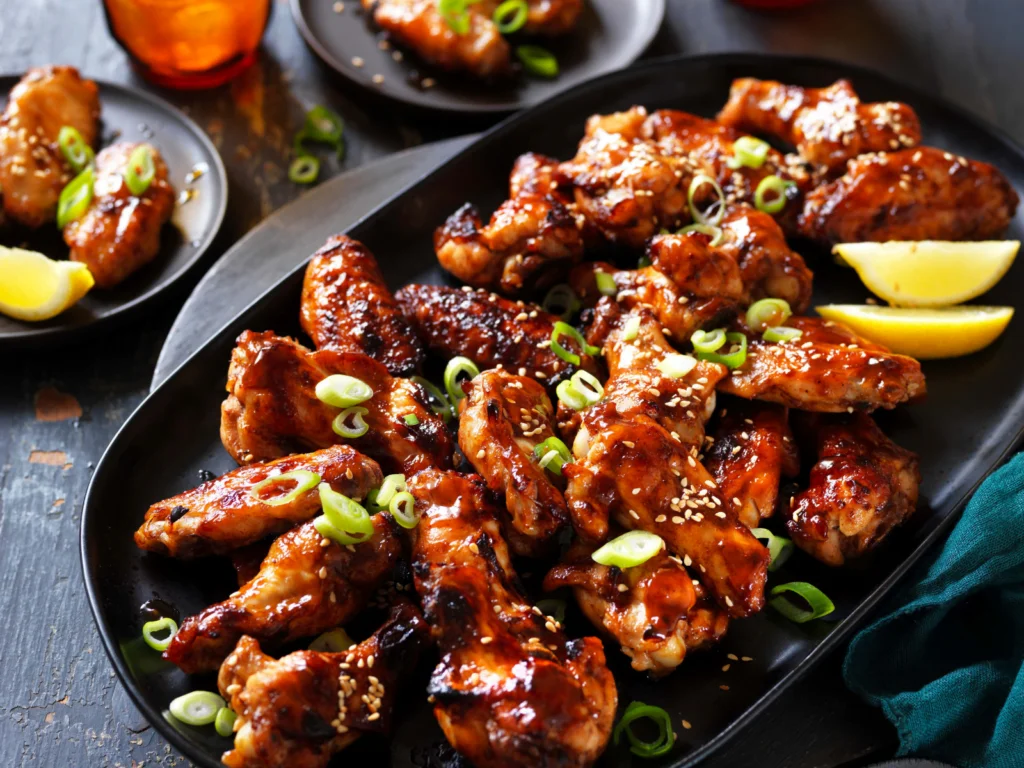


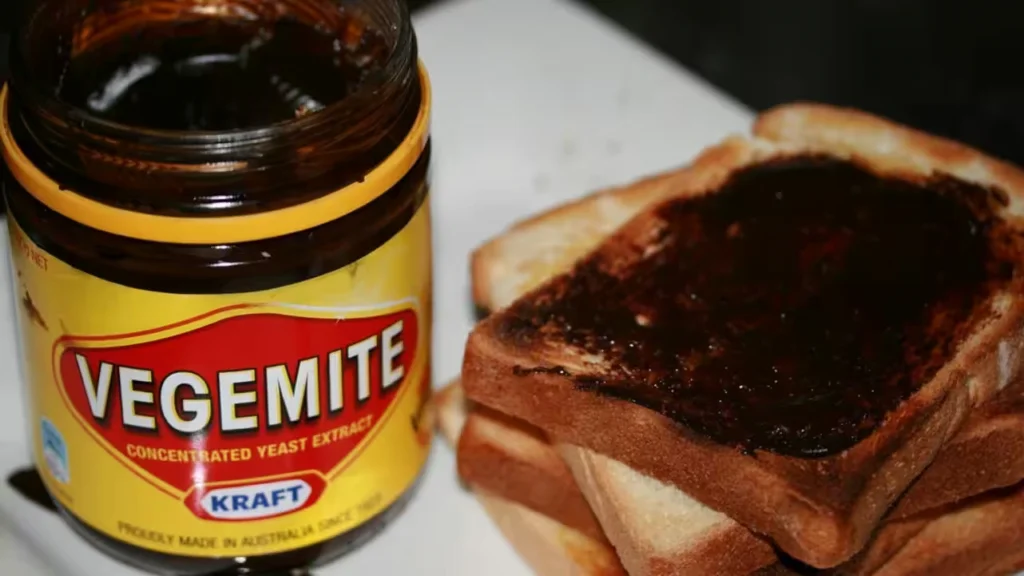
- Damper Bread
- Kangaroo Carpaccio
- Grilled Kangaroo
- Barramundi with Lemon Myrtle
- Australian Meat Pie
- Lamingtons
- Pavlova
10 Fascinating Facts about Australia

Australia, the land of sunshine, koalas, and the Great Barrier Reef, also boasts a reputation for being a bit…well…strange. But beyond the quirky wildlife and laid-back lifestyle, Australia’s legal code and history are sprinkled with some truly fascinating, sometimes bizarre, and downright unbelievable facts.
Buckle up and get ready to dive into the weird and wonderful world of Australia!
The Great Emu War
Believe it or not, in 1932, Australia actually declared war on emus, large flightless birds. The emus, however, proved to be formidable opponents, and the “war” ended in a stalemate. (Yes, you read that right!)
No Potatoe Hoarding!
Section 22 of the Marketing of Potatoes Act 1946 prohibits anyone from selling, delivering, purchasing, or taking delivery of 50kgs (or what appears to be 50kg) or more of potatoes unless you are a member of the Potato Corporation or an authorised agent.
Pink Flamingos are Protected

Australia takes its wildlife seriously. In fact, it’s illegal to harm a flamingo, with potential fines reaching up to $50,000! Guess someone really loves these pink feathered friends.
Beware the Glittering Danger
Opals are a beautiful gemstone found in abundance in Australia. However, it’s illegal to export rough opals, meaning you can only take home the polished variety. So, admire the raw beauty, but don’t try to smuggle it out!
Sign Language for Quokkas?

While there’s no official law, some wildlife centers in Western Australia have adopted a policy of using hand signals to communicate with quokkas, the adorable marsupials, to avoid stressing them out with human voices.
Road Rage on Two Wheels? Not Here
In some parts of Australia, it’s actually illegal for a passenger on a motorbike to wear a helmet if the driver isn’t. Talk about trusting your fellow rider!
Silence is Golden (Unless You’re Voting)

In some polling places in Australia, it’s illegal to speak within a certain distance of the voting booth. Talk about taking a quiet vote seriously!
Beware the Drop Bears (Not Really!)
Tourists are often warned about the mythical “drop bear,” a ferocious koala-like creature that supposedly attacks from trees. Thankfully, this is a playful Aussie joke – koalas are actually quite cuddly (and spend most of their time sleeping).
じゃない (Jyanaika): Don’t Speak Japanese…Literally.
In the 1930s, a law was passed in Queensland making it illegal to speak a language other than English in public. Thankfully, this act was repealed in 1943.
The National Sorry Day

In 1998, Australia formally apologized for the Stolen Generations, the forced removal of Aboriginal children from their families. This national apology marked a significant step towards reconciliation.
So, there you have it! From quirky laws to funny customs, Australia’s unique character shines through. Next time you visit the Land Down Under, you might just encounter one of these fascinating oddities firsthand!
The History and the Affect it Has Had on Australian Cuisine

Australia’s food scene is a vibrant tapestry, woven from the threads of its rich history. Let’s embark on a delicious journey, exploring how each era left its mark on the plates of this fascinating country.
From Ancient Hunters to European Encounters (50,000 Years Ago – 1606 AD)
For millennia, Aboriginal Australians thrived on the land, crafting a unique culinary identity. Kangaroo, emu, fish, and native plants formed the foundation of their diet, a testament to their deep respect for the environment.
This focus on local, sustainable ingredients laid the groundwork for the future of Australian cuisine.
European Arrival and Early Settlement (1606 – 1850)

European explorers like Willem Janszoon and Captain James Cook marked the beginning of a new chapter. British settlement in 1788 brought a wave of new ingredients – wheat, dairy, and livestock.
Traditional British fare like stews and pies found a home Down Under, blending with the existing Aboriginal staples. However, the harsh realities of convict life meant that food was often basic, with staples like bread, salted meat, and gruel forming the mainstay of the diet.
This period also saw the birth of the iconic “damper” – a simple bread made out of flour, water, and sometimes salt, a symbol of resourcefulness in challenging times.
Gold Rush and the Rise of Multicultural Flavors (1851 – 1900)
The discovery of gold in the 1850s sparked a gold rush, attracting immigrants from all corners of the globe.
This influx of diverse cultures had a profound impact on Australian food. Chinese tea houses, Italian cafes, and bakeries began to dot the landscape, introducing new flavors and ingredients. This period marked the beginning of Australia’s vibrant multicultural culinary scene.
The 20th Century: Federation and Beyond (1901 – Present)
Australia’s federation in 1901 ushered in an era of continued cultural exchange. British, Mediterranean, and Asian influences continued to shape the national palate. Dishes like meat pies, lamingtons, and Anzac biscuits became iconic symbols of the Australian identity.
Following World War II, a new wave of immigration introduced a kaleidoscope of flavors: Greek, Italian, Lebanese, Vietnamese, and Indian cuisines all left their mark. This period saw the rise of fusion cuisine, a creative blend of global influences that continues to define modern Australian fare.
Modern Australia: A Celebration of the Land and Beyond

Today, Australia’s culinary scene is a vibrant melting pot. Chefs celebrate the unique bounty of the land – “bush tucker” (native Australian ingredients), fresh seafood, and fragrant native herbs – while incorporating global techniques and traditions. Fine dining flourishes alongside bustling cafe culture and a growing farm-to-table movement.
So next time you take a bite of a juicy Australian lamb burger with a side of Asian slaw, or savor a fragrant Vietnamese pho, remember – it’s all part of the fascinating story woven into the fabric of Australian cuisine.
References
- History of Australia
- Australian Culture: Timeline of Australian History
- Britannica: Australia – Indigenous, Colonization, Federation
- Nations Online Project: History of Australia
How Australia’s Climate and Geography has Influenced Australian Cuisine
Australia isn’t just a big country; it’s a BIG country! The sixth-largest on Earth, this land Down Under boasts a mind-blowing variety of landscapes – from sunbaked deserts to lush rainforests, dramatic mountains to endless coastlines.
And guess what? This incredible geographic diversity has a delicious impact on Australian cuisine! Let’s take a bite-sized tour and see how different regions serve up unique flavors.
Sun, Sand, and Seafood

Australia is an island nation, so it’s no surprise that fresh seafood is a star player across the coast. In tropical Queensland, think juicy prawns, succulent barramundi, and even mud crabs – all waiting to be devoured.
And with a climate that loves sunshine, Queensland also boasts an abundance of tropical fruits like mangoes, bananas, and pineapples, adding a touch of sweetness to the table.
From Vineyards to Laneways

Head south to Victoria and you’ll find Melbourne, a city with a serious love affair with food. Melbourne’s laneways are a haven for hidden cafes and multicultural eateries, offering everything from classic Italian fare (a legacy of past immigration) to trendy fusion dishes. Speaking of Italy, South Australia’s Adelaide region is famed for its world-class wine production,
making it the perfect place to pair a juicy steak on the barbie (that’s Australian for “barbecue”) with a glass of Shiraz.
A Taste of the Outback and Beyond

Travel inland to the vast Outback, and you’ll encounter a different kind of culinary experience. Here, indigenous ingredients like kangaroo, emu, and native fruits like wattleseed and bush tomatoes have been enjoyed by Aboriginal Australians for millennia.
The traditional “damper” – a simple bread cooked over a campfire – is a testament to the resourcefulness of Outback life.
Climate Change and Sustainable Bites

Australia’s unique climate also presents challenges. Water scarcity is a growing concern, forcing farmers to adapt and use water-efficient methods. This highlights the importance of sustainable practices, ensuring future generations can enjoy the bounty of the land.
A Culinary Mosaic
From the fresh seafood of the coast to the hearty flavors of the Outback, and the cosmopolitan delights of Sydney’s cafes, each region of Australia adds a unique tile to the vibrant mosaic of its cuisine.
References
- Australian Conservation Foundation: Australia’s Food Bowl
- Wikipedia: Australian Cuisine
- The Guardian: Geography of Taste
- Tourism Australia: Guide to Australian Cuisine
- ThoughtCo: Geography of Australia
Understanding the Essence of Australian Cuisine

Australia’s food scene is a fascinating paradox. It’s familiar yet surprising, a vibrant tapestry woven from indigenous traditions, global influences, and a healthy dose of Aussie ingenuity.
But what truly sets it apart? Let’s delve into the essence of Australian cuisine, the unique characteristics that make it sing with its own flavorful tune.
A Deep Respect for the Land
Australia’s culinary story begins with its Aboriginal inhabitants. Their deep connection to the land is reflected in their use of native ingredients – “bush tucker” like wattleseed, quandong, and finger limes.
This respect for sustainability continues today, with chefs across the country increasingly incorporating these unique flavors into their dishes.
A Fusion Feast
Australia is a melting pot of cultures, and its cuisine reflects that beautifully. From the legacy of British colonization evident in meat pies and sausage rolls, to the vibrant Asian influences that brought us stir-fries and laksa, Australian food is a delicious global conversation.
This willingness to embrace new flavors and techniques is a defining feature.
Freshness First
Surrounded by pristine coastlines and vast farmlands, Australia boasts an abundance of fresh, high-quality ingredients. From succulent seafood like barramundi and king prawns to juicy cuts of lamb and plump seasonal fruits, Australian cuisine celebrates the bounty of its natural environment.
Chefs showcase these ingredients with simple yet innovative techniques, allowing the natural flavors to shine.
A Laid-Back Approach
Australian culture is known for its relaxed and unpretentious nature, and this attitude extends to its food. Forget stuffy fine dining – Australian cuisine is all about enjoying a delicious meal with good company, whether it’s a barbie on the beach or a casual pub lunch.
It’s a celebration of fresh flavors and shared experiences.
Innovation with a Wink
Australians love a good twist, and their cuisine is no exception. Classic dishes like the humble hamburger get a makeover with beetroot and pineapple, while desserts like pavlova defy categorization.
Australian chefs aren’t afraid to experiment, resulting in a constantly evolving culinary landscape filled with delightful surprises.
Australian Culinary Traditions

Australia’s culinary journey is a fascinating blend of ancient traditions, colonial influences, and a dash of modern invention. Unlike its European counterparts with centuries-old established cuisines, Australia’s food scene is a vibrant, youthful story still being written.
Let’s delve into some of the key traditions that define what it means to eat Australian:
A Legacy from the Land: The Enduring Allure of Bush Tucker
Long before European arrival, Aboriginal Australians thrived for millennia using native ingredients. This unique approach to food, known as “bush tucker,” laid the foundation for Australia’s respect for sustainable practices.
Ingredients like wattleseed (a nutty-flavored seed pod), kangaroo, and native fruits like Davidson plum continue to inspire contemporary chefs, adding a distinctive Australian touch to modern dishes. (Check out https://en.wikipedia.org/wiki/Bush_tucker to learn more about bush tucker!)
A Toast to the Brits: The Comfort of Classics
British colonization in the 18th century left its mark on Australian cuisine. Dishes like meat pies, sausage rolls, and roast dinners became staples, offering a taste of home to early settlers.
These comforting classics continue to hold a special place in Australian hearts, often enjoyed at backyard barbecues or during sporting events. But unlike their British counterparts, Australian takes on these dishes often feature a twist – think chunky lamb fillings in pies or a generous dollop of tomato sauce on a sausage roll.
A Melting Pot Down Under: The Rise of Multicultural Flavors
Australia’s rich multicultural tapestry is a defining characteristic of the nation, and its food scene is no exception. Waves of immigration throughout history have brought a global smorgasbord of flavors.
From Chinese stir-fries and Vietnamese pho to Italian pastas and Greek souvlaki, these influences have become deeply ingrained in Australian cuisine. This willingness to embrace new flavors and techniques continues to this day, making Australian food a dynamic and ever-evolving conversation.
A Cuppa with Character: The Coffee Culture Down Under
Coffee is a serious business in Australia. Forget the weak filter coffee of yesteryear – Australians have embraced a strong, robust coffee culture. The “flat white,” a creamy espresso drink with a smooth microfoam texture, is a national obsession.
(Interested in learning more? Check out https://theconversation.com/topics/coffee-5703)
The Great Aussie Barbie: A Celebration of Food and Community
No discussion of Australian culinary traditions is complete without mentioning the iconic “barbie.” The quintessential Australian barbecue is more than just a way to cook food – it’s a social event, a celebration of community, and a chance to relax outdoors.
Snags (sausages), steaks, and grilled seafood are common favorites, often served with a side of potato salad, damper bread, and a dollop of beetroot. The barbie embodies the relaxed, social nature of Australian culture, bringing people together over shared plates and good company.
With a cup of coffee in hand and a plate piled high with deliciousness, Australia invites you to experience the warmth and vibrancy of its unique culinary traditions.
Exploring Australia’s Ingredients: The Flavors of Australian Cuisine

Australian cuisine is a symphony of flavors, but the instruments that create this delicious melody are the country’s unique ingredients. From ancient “bush tucker” to the bounty of fresh produce, let’s explore the key players that define what goes on an Aussie plate.
A Taste of the Outback: Unveiling Bush Tucker
Long before supermarkets stocked neatly packaged groceries, Aboriginal Australians thrived on a diet rich in native ingredients. This “bush tucker” isn’t just about survival; it’s a celebration of sustainable practices and a connection to the land.
Think beyond the kangaroo – wattleseed (a nutty-flavored seed pod) adds a unique touch to desserts, while Davidson plum, with its tangy citrus flavor, enlivens sauces and marinades. Finger limes, bursting with tiny flavor pearls, are a gourmet’s delight, adding a burst of citrus to seafood dishes.
Exploring bush tucker is a journey into the heart of Australian indigenous culture.
Fresh From the Ocean: A Seafood Lover’s Paradise
Surrounded by pristine coastlines, Australia boasts an abundance of fresh seafood. From the delicate sweetness of king prawns caught off the coast of Western Australia to the meaty barramundi found in tropical Queensland waters, Australian seafood is a celebration of the ocean’s bounty.
Mussels steamed in white wine, succulent grilled fish, and juicy oysters freshly shucked – these are just a few ways Australians enjoy the fruits (or should we say, fins?) of the sea.
A Land Down Under, a Bounty of Fresh Produce
Australia’s diverse climate allows for a wide variety of fruits and vegetables to flourish. Juicy mangoes and pineapples thrive in the tropical north, while crisp apples and pears come from the cooler southern regions.
Don’t forget the iconic Aussie stone fruits – peaches, nectarines, and plums – bursting with sweetness and perfect for summer desserts. But it’s not just about the familiar – native fruits like Davidson plum and quandong offer a unique flavor profile that’s uniquely Australian.
From Paddock to Plate: Celebrating Australian Meat
Meat plays a significant role in Australian cuisine, and the quality is no joke. From succulent lamb chops grilled on the barbie to melt-in-your-mouth wagyu beef, Australian farmers raise some of the best livestock in the world.
Kangaroo, a lean and healthy red meat, is a nod to the country’s indigenous heritage. Whether enjoyed in a classic meat pie or a gourmet burger creation, Australian meat is a guaranteed crowd-pleaser.
A Touch of Spice: Asian Influences on the Rise
Australia’s multicultural population has significantly impacted its food scene. Asian ingredients like lemongrass, ginger, and chilies are finding their way into more and more dishes.
Spicy curries, fragrant stir-fries, and fresh Vietnamese salads all have a place on the Australian table. This willingness to embrace new flavors makes Australian cuisine exciting and ever evolving.
Beyond the Basics
This is just a taste (pun intended!) of the incredible ingredients that make Australian cuisine so unique. From the ancient flavors of bush tucker to the fresh produce grown under the sun, Australian ingredients are a testament to the country’s diverse landscape and rich cultural heritage.
So, next time you sit down to an Australian meal, take a moment to appreciate the unique ingredients that make it all sing.
Mastering Australian Cuisine Cooking Techniques
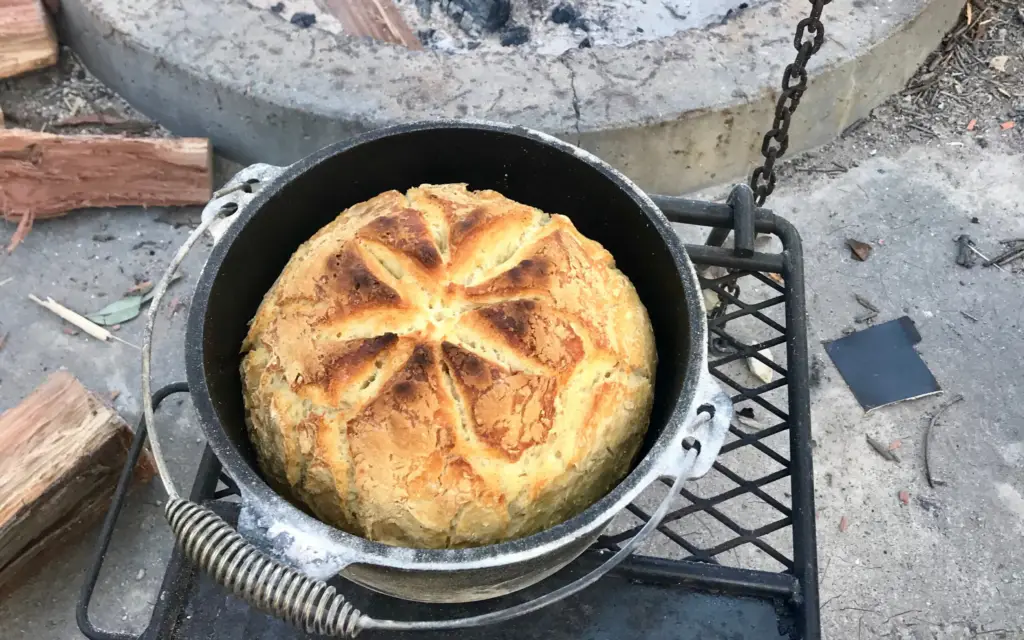
Australia’s culinary scene is a vibrant tapestry, woven from indigenous traditions, global influences, and a healthy dose of Aussie ingenuity. But it’s not just the ingredients that make it special – the cooking techniques used to transform these ingredients into delicious dishes are just as noteworthy.
Let’s fire up the barbie (and explore some other methods!) and discover the unique ways Australians cook their food:
The Humble Campfire’s Legacy: Cooking with Fire
The legacy of Aboriginal Australians lives on in the Australian love affair with cooking over fire. From the iconic barbie, where sizzling snags (sausages) and juicy steaks reign supreme, to damper bread cooked in a camp oven over hot coals, fire is a timeless and versatile cooking method.
Smoking meats for added depth of flavor and slow-cooking stews in camp ovens are all techniques with deep roots in Australia’s culinary history.
A Celebration of Freshness: Simple Techniques Let Ingredients Shine
Australian cuisine often champions fresh, seasonal ingredients. This translates into cooking methods that allow the natural flavors to take center stage. Grilling seafood, whether it’s delicate barramundi or succulent prawns, is a popular technique that brings out the ocean’s sweetness.
Roasting vegetables brings out their natural sugars, while steaming greens ensures they retain their vibrant color and crisp texture. Simplicity is key, allowing the quality of the ingredients to shine through.
A Fusion of Flavors: Borrowing from Global Kitchens
Australia’s multicultural heritage extends to its cooking techniques. Wok-frying, a cornerstone of Asian cuisine, has become a popular way to prepare vegetables and stir-fries.
Italian influence is evident in the use of wood-fired ovens for pizzas and slow-braising techniques for rich ragù sauces. This willingness to borrow and adapt techniques from around the world adds depth and complexity to Australian cuisine.
Innovation Down Under: A Twist on Tradition
Australians love a good twist, and their cooking methods are no exception. Take the humble sausage roll – while the classic version features a flaky pastry filled with savory sausage meat, innovative chefs are experimenting with gourmet fillings like lamb and rosemary or curried vegetables.
Even the barbie gets a makeover – think grilled haloumi cheese drizzled with honey or juicy kangaroo burgers slathered with a native wattle seed paste.
A Modern Approach to Indigenous Techniques
Modern Australian chefs are increasingly looking back to rediscover traditional Aboriginal cooking methods. “Smoking” with native woods like wattle is being used to add a unique flavor profile to meats and seafood.
And “earth oven” cooking, where food is wrapped in leaves and cooked underground, is making a comeback, offering a sustainable and flavorful way to prepare dishes.
Traditional Australian Food
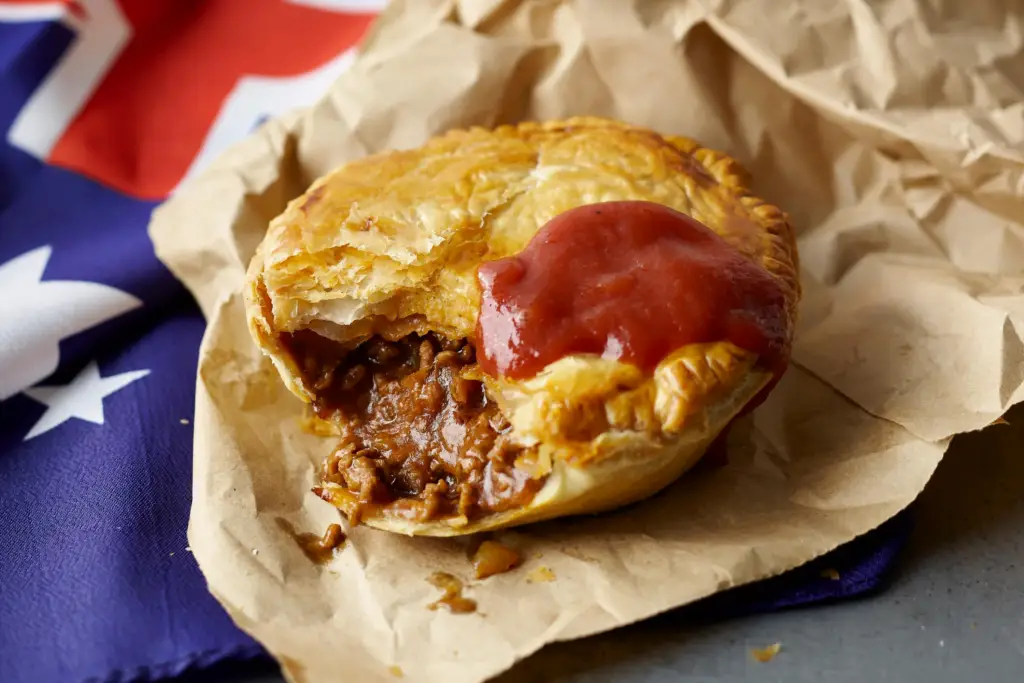
Australia’s culinary scene is a vibrant melting pot, but nestled amongst the global influences lie some true Aussie classics. These dishes are more than just food; they’re a delicious journey through the country’s history and culture.
So, grab a plate and dig into 5 traditional Australian food experiences:
The Humble (and Beloved) Meat Pie
No discussion of Australian food is complete without mentioning the mighty meat pie. This handheld savory delight features a flaky pastry crust filled with a rich gravy and chunks of tender meat, typically beef or lamb.
Enjoy it as a quick lunch on the go, a hearty snack at the footy (Australian Rules Football) game, or a comforting part of a pub meal. Simple yet satisfying, the meat pie is a true Aussie icon.
A Slice of Sunshine: Lamington
Calling all sponge cake lovers! The lamington is a quintessential Australian dessert. Squares of light and fluffy vanilla sponge cake are dipped in a layer of melted chocolate, then rolled in desiccated coconut.
The result? A delightful textural contrast between the soft cake, rich chocolate, and crunchy coconut. Lamingtons are perfect with a cup of tea or coffee, and a staple at afternoon teas and bake sales across the country.
A Sweet and Savory Sensation: Vegemite Toast
Love it or hate it, Vegemite is a defining flavor of Australian cuisine. This dark brown paste, made from brewer’s yeast extract, has a strong, salty, and slightly umami taste.
The classic way to enjoy it is on toast – a generous smear of Vegemite, perhaps with a pat of butter for those who prefer a milder experience. While it might be an acquired taste for some, Vegemite is a true Aussie breakfast staple.
A Celebration of Seafood: Barramundi and Chips
Australia’s vast coastline provides an abundance of fresh seafood, and barramundi is a national favorite. This white fish with its mild flavor and firm texture is incredibly versatile.
But one of the most popular ways to enjoy it is simply grilled or pan-fried, served with golden chips (French fries) and a squeeze of lemon. Simple, delicious, and showcasing the quality of Australian produce, barramundi and chips is a true taste of the coast.
A Hearty Outback Staple: Damper
Traveling inland to the vast Outback, we encounter a different kind of culinary experience. Damper is a simple bread traditionally cooked by Aboriginal Australians over a campfire.
Made with flour, water, and sometimes a pinch of salt, damper is a testament to the resourcefulness of Outback life. Today, damper is enjoyed not just by travelers and campers, but also at barbecues and as a side dish for stews and curries. Its simple ingredients and rustic charm make damper a true Aussie classic.
These five dishes offer just a glimpse into the rich tapestry of Australian food traditions. From the comforting classics to the fresh seafood specialties, each bite tells a story of the land, its people, and their unique culinary journey.
Exploring Australian Street Food

Australia’s culinary scene isn’t confined to fancy restaurants. In recent years, a vibrant street food culture has exploded across the country, offering a delicious and affordable way to experience a diverse range of flavors.
From fresh seafood by the beach to multicultural bites in bustling city laneways, Australian street food is a feast for the senses. Let’s grab a paper plate and dive into this delicious world!
Cities Leading the Charge
While street food can be found in most Australian cities, some boast particularly vibrant scenes:
- Melbourne: Renowned for its laneway culture, Melbourne offers a smorgasbord of street food options. From Vietnamese banh mi to gourmet hot dogs and drool-worthy dumplings, there’s something for every taste bud.
- Sydney: Sydney’s multicultural heart is reflected in its street food scene. Sample succulent Korean BBQ skewers, savor melt-in-your-mouth bao buns, or grab a cheesy halal snack pack – a local favorite.
- Brisbane: Brisbane’s street food scene is known for its fresh and innovative offerings. Think colorful poke bowls piled high with fresh seafood, perfectly seasoned pulled pork rolls, or decadent wood-fired pizzas.
5 Street Food Must-Tries
1. The Iconic Sausage Roll: A true Aussie classic, the humble sausage roll gets a street food makeover. Think gourmet fillings like lamb and rosemary or curried vegetables encased in flaky pastry perfection.
2. The Flavorful Falafel Wrap: Falafel wraps are a staple across Australia’s street food scene. Crispy falafel balls are tucked into warm pita bread with fresh salad, creamy hummus, and a drizzle of tahini sauce – a delicious and satisfying vegetarian option.
3. The Asian-Inspired Dumplings: From delicate steamed har gow to pan-fried gyoza, dumplings are a popular street food choice. Filled with savory meats and vegetables, they offer a delightful explosion of flavor in every bite.
4. The Fresh and Healthy Poke Bowl: Perfect for a light lunch or a beachside snack, poke bowls are a healthy street food trend. A base of sushi rice is topped with fresh diced raw fish, vibrant vegetables, and a variety of sauces – a delicious and Instagram-worthy option.
5. The Sweet Treat: Fairy Bread: No exploration of Australian street food is complete without a touch of sweetness. Fairy bread is a nostalgic treat – simple white bread squares topped with hundreds and thousands (colorful sprinkles) – a delightful reminder of childhood.
Beyond the Bites:
The beauty of Australian street food goes beyond just the delicious bites. It’s about the atmosphere – the buzz of city life, the aroma of spices wafting through the air, and the friendly interaction with vendors. So next time you’re exploring Australia, don’t just wander past the street food stalls – dive in, grab a bite, and experience the vibrant energy of Australian food culture.
The Most Popular the Australian Food Recipes

Australia boasts a rich culinary heritage influenced by its diverse population and unique indigenous ingredients. From savory meat pies to indulgent desserts, Australian cuisine offers a delightful array of flavors.
Let’s explore ten of the most popular Australian recipes that are sure to tantalize your taste buds.
Pavlova
A quintessential Australian dessert, Pavlova features a crisp meringue base topped with whipped cream and fresh fruit such as kiwi, strawberries, and passionfruit. This light and airy treat is perfect for any occasion, from casual gatherings to festive celebrations.
Lamingtons
Lamingtons are sponge cake squares dipped in chocolate icing and coated with desiccated coconut. These delicious bites are a beloved Australian treat, often enjoyed with a cup of tea or coffee for a delightful afternoon snack.
Meat Pie
A staple of Australian cuisine, the meat pie consists of flaky pastry filled with savory minced meat, gravy, and sometimes onions. Whether enjoyed at a sporting event or as a quick meal on the go, the meat pie is a comforting and satisfying option.
Tim Tam Slam
A fun and indulgent Australian tradition, the Tim Tam Slam involves biting off opposite corners of a Tim Tam chocolate biscuit and using it as a straw to sip hot coffee or milk. The biscuit softens from the liquid, creating a heavenly chocolatey experience.
Anzac Biscuits
Anzac biscuits are oat-based cookies with a crispy texture and a hint of golden syrup. These biscuits have historical significance, as they were originally made by Australian and New Zealand Army Corps (ANZAC) soldiers during World War I.
Today, they are enjoyed as a delicious treat on Anzac Day and throughout the year.
Barramundi with Lemon Butter Sauce
Barramundi, a popular Australian fish, is often served with a tangy lemon butter sauce. This dish showcases the fresh flavors of the sea and is typically accompanied by steamed vegetables or a side of salad, making it a healthy and flavorful meal option.
Damper
Damper is a traditional Australian bread made from flour, water, and a pinch of salt, then baked in the coals of a campfire. This rustic bread has a dense texture and a slightly crispy crust, making it a perfect accompaniment to soups, stews, or enjoyed with butter and jam.
Kangaroo Steak
The meat is lean, tender, and packed with flavor, making it a popular choice for grilling or pan-searing. Kangaroo steak is often served medium-rare to preserve its natural juices and is complemented by a variety of sauces or marinades.
Chicken Parmigiana
Also known as “chicken parma” or “parmi,” this classic Australian pub dish features breaded and fried chicken breast topped with tomato sauce, melted cheese, and sometimes ham. Served with a side of chips (French fries) or salad, chicken parmigiana is a hearty and satisfying meal.
Pumpkin Soup
Pumpkin soup is a comforting and nutritious dish made from roasted pumpkin, onions, garlic, and spices, blended to a smooth consistency. Often garnished with a dollop of cream or yogurt and a sprinkle of fresh herbs, this soup is perfect for warming up on chilly Australian evenings.
Whether you’re craving something sweet, savory, or somewhere in between, these ten popular Australian recipes are sure to satisfy your appetite and introduce you to the flavors of the Land Down Under.
What are the Health Implications of Australian Cuisine?

What we eat and how healthy we are are two sides of the same coin, and Australia is no exception. Let’s dive into the delicious world of Aussie food and explore some of the health challenges faced by the population.
Aussie Tucker on Your Plate
The Australian Dietary Guidelines are like a roadmap to healthy eating Down Under.
They recommend a balanced diet packed with goodness:
- Five Food Friends: Think fruits bursting with color, rainbow vegetables, whole grains for energy, lean protein to keep you feeling full, and dairy products for strong bones.
- Mind Your Portions: Don’t go overboard! Moderation is key to a healthy diet.
- Sugar and Salt? Less is More: Ditch the sugary drinks and snacks, and go easy on the salt shaker.
- Fat Choice Matters: Swap saturated fats (think fatty meats) for unsaturated fats (think avocado and olive oil) for a heart-healthy approach.
The Australian Guide to Healthy Eating puts a picture to these words, making it easy to visualize a balanced plate.
But Here’s the Catch
While there’s a clear roadmap to healthy eating, some challenges persist:
- Processed Food Frenzy: Australians love convenience, but unfortunately, that often means reaching for processed and ultra-processed foods. These can be loaded with unhealthy fats, sugars, and sodium.
- The Battle of the Bulge: Obesity rates are on the rise in Australia, partly linked to unhealthy food choices.
Health Concerns Down Under
The Australian Burden of Disease Study 2022 paints a picture of the health landscape in Australia. Here are some key takeaways:
- Living with Illness: More than half (52%) of the total health burden in Australia comes from people living with chronic illnesses or injuries.
- Fewer Early Departures: The good news is that fewer Australians are dying prematurely compared to the past.
- The Shift: This means the focus is shifting towards managing chronic illnesses that can impact quality of life.
Specific Conditions to Watch
- High Cholesterol: One in ten Australians (8.4%) have high cholesterol, and this risk increases with age.
- Heart Trouble: Coronary heart disease remains a major health concern.
- Stroke: Another contributor to illness and disability.
- Diabetes: A serious condition linked to 11% of adult deaths in Australia. It often goes hand-in-hand with heart disease and kidney problems.
- Ageing Population: As Australians live longer, chronic diseases become more common.
Not Created Equal
Sadly, Indigenous Australians face a greater burden of chronic diseases and food-related illnesses compared to the rest of the population.
So, what’s the Takeaway?
Australia has a delicious and diverse food scene, but there’s room for improvement when it comes to healthy eating habits. By making informed choices and focusing on fresh, whole foods, Australians can enjoy a long and healthy life Down Under.
References:
- Australian Guide to Healthy Eating
- Australian Burden of Disease Study 2022
- High Cholesterol Statistics
- Heart, Stroke, and Vascular Disease Facts
- Diabetes Facts
Australia’s National Dish

Unlike some countries with centuries-old established cuisines, Australia’s national dish remains a topic of friendly debate.
So, what’s the hold-up? Let’s explore the contenders for the title of “Australia’s National Dish” and see why a definitive answer might be as elusive as a perfectly golden snag (sausage) at a barbie (barbecue).
Strong Contenders in the Ring
Several dishes consistently vie for the top spot:
- The Humble Meat Pie: This handheld favorite, with its flaky pastry encasing a rich gravy and tender meat filling, is a true Aussie icon. Found at bakeries, sporting events, and even petrol stations, the meat pie is a symbol of convenience and comfort food.
- The Classic Roast Lamb: Sunday roasts are a tradition in many cultures, and Australia is no exception. Succulent roast lamb with roasted vegetables and gravy is a hearty and satisfying meal, perfect for bringing families and friends together. A 2013 survey even crowned roast lamb “Australia’s National Dish.”
- The Iconic Vegemite Toast: Love it or hate it, Vegemite – a dark brown spread made from brewer’s yeast extract – is a defining flavor of Australia. Smothered on toast (with or without butter!), it’s a classic breakfast option and a source of national pride (or amusement, depending on who you ask).
- The All-Aussie Barbie Spread: It’s hard to talk about Australian food without mentioning the barbie. While not a single dish itself, the barbie experience – sizzling snags (sausages), grilled seafood, and juicy steaks – is a quintessential part of Australian culture.
Why the Lack of a Clear Winner?
So, why can’t Australia just pick one? Here are a few reasons:
- A Young and Evolving Cuisine: Compared to European countries with centuries-old food traditions, Australian cuisine is still young and evolving. This means there’s no single dish with a long and established history.
- A Diverse Food Landscape: Australia’s multicultural population means its food scene is incredibly diverse. From fresh seafood to indigenous ingredients, there’s something for everyone, making it hard to pick just one dish to represent the entire nation.
- A Relaxed and Unpretentious Culture: Australians are known for their laid-back attitude, and this extends to their food. There’s less emphasis on strict culinary traditions and more on enjoying a delicious meal with good company.
The Beauty Lies in the Journey
The lack of a single national dish might be seen as a drawback, but it can also be considered a strength. It reflects the vibrant and ever-changing nature of Australian cuisine. Perhaps the true beauty lies in the journey of exploration – from the comforting classics to the innovative creations of modern chefs.
Don’t be afraid to experiment. Sample a meat pie, savor a roast lamb dinner, or spread some Vegemite on toast (if you dare!). The most important thing is to enjoy the delicious adventure that is Australian food.
Australian Cuisine – Great recipes to try at home

Here’s your one-stop guide to recreating delicious and iconic Australian dishes right in your own kitchen.
We’ve got all the classics covered, from the golden, flaky goodness of a meat pie to the sweet and delightful lamington. Feeling like some fresh seafood? Dive into a plate of perfectly grilled barramundi and chips, or impress your friends with a flavorful prawn barbie.
But wait, there’s more! We’ll also explore some hidden gems of Aussie cuisine, introducing you to the simple yet satisfying damper bread and the unique taste of Vegemite toast (love it or hate it!).
So, grab your apron, fire up the stove, and get ready to embark on a delicious culinary journey to Australia. With our easy-to-follow recipes and handy tips, you’ll be a pro at whipping up true Aussie tucker in no time! Let’s get cooking!
Australian Food – Sausage Roll

Sausage Roll: A Taste of Aussie Comfort Food
As a traveler and food enthusiast, I’m always on the lookout for dishes that capture the essence of a region. Today, we’re diving into the heart of Australian comfort food with the iconic sausage roll.
Originating from Australia, this beloved snack has found its way into cafes, bakeries, and homes across the country. Let’s explore the history and flavors behind this classic Aussie treat.
History and Background:
The sausage roll has humble origins, dating back to the early 19th century when British immigrants brought their love of savory pastry dishes to Australia. Over time, the recipe evolved to include a seasoned mixture of ground meat, typically pork or beef, encased in flaky puff pastry.
Sausage rolls became a popular snack food, enjoyed by Aussies of all ages at picnics, parties, and as a quick bite on the go.
Australian Food – Sausage Roll Ingredients:
- 500g pork sausage meat
- 1 onion, finely chopped
- 2 cloves garlic, minced
- 1 tablespoon Worcestershire sauce
- 1 teaspoon dried mixed herbs
- Salt and pepper to taste
- 2 sheets of puff pastry, thawed
- 1 egg, beaten (for egg wash)
Australian Food – Sausage Roll Recipe (Serves 4):
- Preheat Oven: Preheat your oven to 200°C (390°F) and line a baking tray with parchment paper.
- Prepare Filling: In a mixing bowl, combine the pork sausage meat, finely chopped onion, minced garlic, Worcestershire sauce, dried mixed herbs, salt, and pepper. Mix well until all ingredients are evenly distributed.
- Assemble Rolls: Cut each sheet of puff pastry in half lengthwise, creating four long rectangles. Divide the sausage mixture evenly among the pastry rectangles, placing it along one edge.
- Roll and Seal: Roll the pastry over the sausage mixture, enclosing it completely. Press the edges to seal and place the rolls seam side down on the prepared baking tray.
- Brush with Egg Wash: Brush the tops of the sausage rolls with beaten egg, which will give them a golden, glossy finish when baked.
- Bake: Transfer the tray to the preheated oven and bake for 25-30 minutes, or until the pastry is puffed and golden brown, and the sausage filling is cooked through.
- Serve: Allow the sausage rolls to cool slightly before serving. They can be enjoyed hot or cold, on their own or with your favorite dipping sauce.
Cooking Time:
- Approximately 25-30 minutes
Nutritional Information (per serving):
- Calories: Approximately 450 kcal
- Protein: Approximately 15g
- Fat: Approximately 30g
- Carbohydrates: Approximately 30g
- Fiber: Approximately 2g
With just a handful of ingredients and a simple preparation method, you can recreate the delicious taste of Aussie sausage rolls right in your own kitchen. Whether enjoyed as a snack, appetizer, or part of a picnic spread, these savory pastries are sure to satisfy your cravings for a taste of Down Under.
Australian Food – Falafel Wrap

Discovering the Aussie Twist on Falafel: The Falafel Wrap
As a food lover and globetrotter, I’m always on the lookout for culinary treasures from around the world. Today, we’re exploring an Aussie twist on a Middle Eastern favorite: the Falafel Wrap.
Originating from the vibrant food scene of Australia, this fusion dish combines the flavors of crispy falafel, fresh vegetables, and creamy sauces, all wrapped up in a warm tortilla. Let’s delve into the history and background of this delightful creation.
History and Background:
In Australia, where multiculturalism thrives, diverse culinary influences converge to create innovative dishes like the Falafel Wrap. While falafel itself has its roots in the Middle East, Australian chefs and home cooks have adapted the recipe to suit local tastes, incorporating unique ingredients and flavors. The result is a satisfying and flavorful handheld meal that reflects the multicultural identity of modern Australian cuisine.
Australian Food – Falafel Wrap Ingredients:
- 1 cup dried chickpeas, soaked overnight
- 1 small onion, roughly chopped
- 2 cloves garlic, minced
- 1/4 cup fresh parsley, chopped
- 1 teaspoon ground cumin
- 1 teaspoon ground coriander
- 1/2 teaspoon baking powder
- Salt and pepper to taste
- 2 tablespoons all-purpose flour
- Oil for frying
- Tortillas or wraps
- Lettuce, shredded
- Tomato, sliced
- Cucumber, sliced
- Tzatziki or hummus, for serving
Australian Food – Falafel Wrap Recipe (Serves 4):
- Prepare Chickpeas: Drain and rinse the soaked chickpeas. Place them in a food processor along with the chopped onion, minced garlic, fresh parsley, ground cumin, ground coriander, baking powder, salt, and pepper.
- Blend Mixture: Pulse the mixture in the food processor until it forms a coarse paste. Be careful not to over-process; you want some texture to remain.
- Form Falafel Patties: Transfer the falafel mixture to a bowl and stir in the all-purpose flour. Use your hands to shape the mixture into small patties, about the size of a golf ball.
- Fry Falafel: Heat oil in a frying pan over medium heat. Fry the falafel patties for 2-3 minutes on each side, or until they are golden brown and crispy. Remove from the pan and drain on paper towels to remove excess oil.
- Assemble Wraps: Warm the tortillas or wraps in a dry skillet or microwave. Place a generous amount of shredded lettuce, sliced tomato, and cucumber down the center of each tortilla. Top with the freshly fried falafel patties.
- Add Sauce: Drizzle tzatziki or hummus over the falafel, according to your preference.
- Wrap and Serve: Fold the sides of the tortilla over the filling and roll it up tightly, securing with parchment paper or foil if needed. Serve immediately and enjoy!
Cooking Time:
- Approximately 20-25 minutes
Nutritional Information (per serving):
- Calories: Approximately 300 kcal (excluding sauce and tortilla)
- Protein: Approximately 10g
- Fat: Approximately 10g
- Carbohydrates: Approximately 40g
- Fiber: Approximately 8g
With its flavorful falafel, crisp vegetables, and creamy sauces, the Aussie Falafel Wrap offers a delicious taste of fusion cuisine that’s perfect for a quick lunch or dinner on the go. Give it a try and experience the culinary creativity of Down Under!
Australian Food – Steamed Har Gow

Exploring Australian Dim Sum: Steamed Har Gow
As a food enthusiast and owner of a small restaurant, I’m always excited to explore new flavors and culinary traditions. Today, let’s journey into the realm of Australian dim sum with Steamed Har Gow.
Originating from the bustling Chinatowns of cities like Sydney and Melbourne, Steamed Har Gow is a delightful Cantonese dumpling filled with juicy shrimp and wrapped in a translucent, chewy wrapper. Let’s delve into the history and background of this beloved dish.
History and Background:
In Australia, where multiculturalism thrives, Chinese cuisine holds a special place in the hearts (and stomachs) of many. Steamed Har Gow, also known as shrimp dumplings, is a popular dim sum dish that has been embraced by Aussies of all backgrounds.
Originating from the Guangdong province of China, Har Gow has been adapted and reimagined in Australian Chinese communities, becoming a staple on dim sum menus and in home kitchens across the country.
Australian Food – Steamed Har Gow Ingredients:
- 200g raw shrimp, peeled and deveined
- 1 tablespoon cornstarch
- 1 tablespoon soy sauce
- 1 teaspoon sesame oil
- 1 teaspoon sugar
- 1/4 teaspoon white pepper
- Pinch of salt
- 1/4 cup finely chopped bamboo shoots
- 1/4 cup finely chopped water chestnuts
- 1 tablespoon finely chopped spring onions (green parts only)
- 1 packet of round dumpling wrappers
- Water, for steaming
Recipe (Makes approximately 20 dumplings):
- Prepare Shrimp Filling: Pat the peeled and deveined shrimp dry with paper towels. In a mixing bowl, combine the shrimp with cornstarch, soy sauce, sesame oil, sugar, white pepper, and a pinch of salt. Mix well to coat the shrimp evenly.
- Add Vegetables: Stir in the finely chopped bamboo shoots, water chestnuts, and spring onions, combining everything thoroughly.
- Assemble Dumplings: Place a small spoonful of the shrimp filling in the center of a dumpling wrapper. Moisten the edges of the wrapper with water, then fold it in half to encase the filling. Pleat the edges together to seal the dumpling, ensuring there are no gaps.
- Repeat: Continue filling and folding the remaining dumpling wrappers until all the filling is used up, making approximately 20 dumplings in total.
- Steam Dumplings: Arrange the dumplings in a single layer on a lightly greased steamer basket or bamboo steamer. Steam over boiling water for 8-10 minutes, or until the shrimp is cooked through and the wrappers are translucent and slightly translucent.
- Serve: Carefully remove the steamed Har Gow from the steamer and serve immediately with soy sauce, chili oil, or your favorite dipping sauce.
Cooking Time:
- Approximately 8-10 minutes
Nutritional Information (per serving, based on 4 dumplings):
- Calories: Approximately 150 kcal
- Protein: Approximately 15g
- Fat: Approximately 3g
- Carbohydrates: Approximately 15g
- Fiber: Approximately 1g
With their delicate wrappers and flavorful shrimp filling, Steamed Har Gow is a delicious taste of Australian dim sum that’s perfect for sharing with friends and family. Give this recipe a try and experience the culinary diversity of Down Under!
Australian Food – Pan-Fried Gyoza

Delving into Fusion Flavors: Pan-Fried Gyoza with an Aussie Twist
As a food enthusiast with a passion for blending culinary traditions, I’m always excited to explore fusion dishes that showcase the diversity of flavors. Today, we’re diving into the world of Australian-Japanese fusion with Pan-Fried Gyoza.
Originating from the dynamic food scene of cities like Sydney and Melbourne, this dish combines the techniques of Japanese dumpling making with locally sourced Australian ingredients. Let’s uncover the history and background behind this delicious fusion creation.
Australian Food – Pan-Fried Gyoza History and Background:
In Australia, where multiculturalism flourishes, Japanese cuisine holds a special place among food lovers. Gyoza, or Japanese dumplings, have become a popular dish in Australian restaurants and homes alike.
With a nod to Japanese tradition and a twist of Aussie flair, Pan-Fried Gyoza reflects the culinary creativity and diversity of modern Australian cuisine.
Australian Food – Pan-Fried Gyoza Ingredients:
- 250g ground pork
- 1 cup finely shredded cabbage
- 2 cloves garlic, minced
- 1 tablespoon ginger, grated
- 2 tablespoons soy sauce
- 1 tablespoon sesame oil
- 1 teaspoon sugar
- 1/2 teaspoon salt
- 1/4 teaspoon black pepper
- 1 packet of gyoza wrappers
- 2 tablespoons vegetable oil
- Dipping sauce (soy sauce, rice vinegar, and chili oil), for serving
Australian Food – Pan-Fried Gyoza Recipe (Makes approximately 20 gyoza, serves 4):
- Prepare Filling: In a mixing bowl, combine the ground pork, finely shredded cabbage, minced garlic, grated ginger, soy sauce, sesame oil, sugar, salt, and black pepper. Mix well until all ingredients are evenly incorporated.
- Wrap Gyoza: Place a small spoonful of the filling in the center of a gyoza wrapper. Moisten the edges of the wrapper with water, then fold it in half to form a half-moon shape. Pleat the edges together to seal the gyoza, ensuring there are no gaps.
- Repeat: Continue filling and folding the remaining gyoza wrappers until all the filling is used up, making approximately 20 gyoza in total.
- Pan-Fry Gyoza: Heat vegetable oil in a large skillet or frying pan over medium-high heat. Once hot, arrange the gyoza in a single layer in the pan, ensuring they are not touching each other. Cook for 2-3 minutes, or until the bottoms are golden brown.
- Add Water and Cover: Carefully pour water into the pan until it reaches about halfway up the sides of the gyoza. Cover the pan with a lid and reduce the heat to medium-low. Allow the gyoza to steam for 5-6 minutes, or until the filling is cooked through and the wrappers are translucent.
- Serve: Remove the lid from the pan and continue cooking the gyoza uncovered for another 1-2 minutes, or until the water has evaporated and the bottoms are crispy again. Transfer the gyoza to a serving plate and serve immediately with dipping sauce.
Cooking Time:
- Approximately 15-20 minutes
Nutritional Information (per serving, based on 5 gyoza):
- Calories: Approximately 250 kcal
- Protein: Approximately 10g
- Fat: Approximately 15g
- Carbohydrates: Approximately 20g
- Fiber: Approximately 2g
With their crispy bottoms, juicy filling, and umami-rich dipping sauce, Pan-Fried Gyoza offers a delightful fusion of Japanese and Australian flavors that’s sure to satisfy your cravings. Give this recipe a try and experience the best of both worlds!
Australian Food – Poke Bowl

Exploring Coastal Delights: The Australian Poke Bowl
As a food explorer and restaurant owner, I’m always on the lookout for fresh and vibrant dishes that capture the essence of a region. Today, we’re diving into the coastal flavors of Australia with the Australian Poke Bowl.
Originating from the sunny shores of places like Bondi Beach in Sydney and St Kilda in Melbourne, this colorful bowl combines the best of Australian seafood with the flavors of Hawaii. Let’s uncover the history and background behind this delicious fusion dish.
History and Background:
In Australia, where beach culture is deeply ingrained, the Poke Bowl has become a popular choice among health-conscious foodies and beachgoers alike. Inspired by the traditional Hawaiian dish, Australian Poke Bowls feature a variety of fresh seafood, vibrant vegetables, and flavorful sauces.
With its emphasis on fresh, quality ingredients and bold flavors, the Australian Poke Bowl reflects the coastal lifestyle and culinary diversity of the Land Down Under.
Australian Food – Poke Bowl Ingredients:
- 2 cups cooked sushi rice
- 200g sushi-grade salmon, cubed
- 200g sushi-grade tuna, cubed
- 1 avocado, sliced
- 1/2 cucumber, thinly sliced
- 1/2 carrot, julienned
- 1/4 red cabbage, thinly sliced
- 1/4 cup edamame beans, cooked
- 2 tablespoons pickled ginger
- 2 tablespoons seaweed salad
- 2 tablespoons sliced spring onions (green parts only)
- Sesame seeds, for garnish
- Soy sauce, for drizzling
- Sriracha mayo or spicy mayo, for drizzling
Australian Food – Poke Bowl Recipe (Serves 2):
- Prepare Sushi Rice: Cook sushi rice according to package instructions and let it cool to room temperature.
- Prepare Seafood: Cube the sushi-grade salmon and tuna into bite-sized pieces.
- Assemble Ingredients: Arrange the cooked sushi rice in the bottom of two bowls. Top with cubed salmon, tuna, sliced avocado, thinly sliced cucumber, julienned carrot, thinly sliced red cabbage, and cooked edamame beans.
- Add Garnishes: Scatter pickled ginger, seaweed salad, and sliced spring onions over the ingredients in the bowls.
- Garnish: Sprinkle sesame seeds over the bowls for added crunch and flavor.
- Drizzle Sauces: Drizzle soy sauce and sriracha mayo or spicy mayo over the poke bowls according to your preference.
- Serve: Serve the Australian Poke Bowls immediately, allowing diners to mix the ingredients and sauces together before enjoying.
Cooking Time:
- Approximately 30 minutes (including rice cooking time)
Nutritional Information (per serving):
- Calories: Approximately 550 kcal
- Protein: Approximately 30g
- Fat: Approximately 25g
- Carbohydrates: Approximately 45g
- Fiber: Approximately 8g
With its colorful array of fresh seafood, vibrant vegetables, and bold flavors, the Australian Poke Bowl is a delicious and healthy meal that captures the coastal spirit of Australia. Whether you’re dining beachside or at home, this flavorful dish is sure to transport you to the sunny shores of Down Under.
Australian Food – Vegemite Toast

Exploring Australian Cuisine: The Iconic Vegemite Toast
G’day, mates! Today, we’re diving into the heart of Australian cuisine with a classic: Vegemite Toast. This iconic dish is a staple in Aussie households and cafes alike.
Vegemite, a dark brown paste made from leftover brewers’ yeast extract with various vegetable and spice additives, is spread generously on toast and enjoyed for breakfast, brunch, or any time of the day. Let’s uncover the history and essence of this beloved Australian treat.
Vegemite Toast originated in Australia in the 1920s when Cyril Percy Callister, a food technologist, created the spread as a way to utilize brewers’ yeast extract, a by-product of beer manufacturing.
Since then, it has become an integral part of Australian culture, with locals consuming it in various ways, from spreading it on toast to incorporating it into recipes like Vegemite and cheese scrolls or Vegemite-infused meat pies. Aussies often describe its taste as salty, savory, and uniquely delicious, making it a quintessential Australian flavor experience.
Australian Food – Vegemite Toast Ingredients:
- 2 slices of whole grain bread
- 2 teaspoons of unsalted butter
- 2 teaspoons of Vegemite
- Optional: avocado slices, sliced tomatoes, or poached eggs for serving
Australian Food – Vegemite Toast Recipe:
1. Preparing Ingredients:
- Bread: Check if the slices of whole grain bread are fresh and not stale.
- Butter: Measure out 2 teaspoons of unsalted butter.
- Vegemite: Measure out 2 teaspoons of Vegemite.
2. Cooking Instructions:
- Toasting Bread: Place the slices of bread in a toaster and toast until golden brown.
- Spreading Butter: Once toasted, spread 1 teaspoon of unsalted butter evenly over each slice of toast while they are still warm.
- Applying Vegemite: Using a butter knife, spread 1 teaspoon of Vegemite on each slice of buttered toast, ensuring an even coating.
- Optional Toppings: If desired, top the Vegemite toast with avocado slices, sliced tomatoes, or poached eggs for added flavor and nutrition.
Serving:
- Serve the Vegemite Toast immediately while it’s still warm for the best taste and texture.
- Enjoy this Australian classic for breakfast, brunch, or a satisfying snack.
Serving Size: This recipe serves 1 person.
Estimated Cooking Time: 5 minutes
Nutritional Information (per serving):
- Calories: 235
- Total Fat: 10g
- Saturated Fat: 4g
- Trans Fat: 0g
- Cholesterol: 15mg
- Sodium: 530mg
- Total Carbohydrates: 29g
- Dietary Fiber: 5g
- Sugars: 3g
- Protein: 9g
So, there you have it—Vegemite Toast, an Aussie classic that’s simple, savory, and oh-so-delicious. Whether you’re enjoying it Down Under or bringing a taste of Australia to your own kitchen,
Australian Food – Anzac Biscuits

Exploring Australian Cuisine: Anzac Biscuits
G’day, foodies! Today, we’re delving into the rich culinary heritage of Australia with a beloved treat: Anzac Biscuits. These sweet, crunchy biscuits have a fascinating history, originating from the Anzacs (Australian and New Zealand Army Corps) during World War I.
Let’s uncover the story behind these iconic biscuits and learn how to make them right in your own kitchen.
Anzac Biscuits have a special place in Australian history. During World War I, soldiers’ rations were limited, and these biscuits became a popular homemade treat sent by wives and women’s groups to soldiers overseas. They were cherished for their long shelf life and delicious taste, providing a taste of home to the Anzacs amidst the hardships of war.
Today, Anzac Biscuits remain a symbol of resilience, community, and the Anzac spirit.
Australian Food – Anzac Biscuits Ingredients:
- 1 cup (90g) rolled oats
- 1 cup (150g) all-purpose flour
- 1 cup (220g) brown sugar
- 1/2 cup (115g) unsalted butter
- 2 tablespoons (40g) golden syrup or honey
- 1 teaspoon (5g) baking soda
- 2 tablespoons (30ml) boiling water
Australian Food – Anzac Biscuits Recipe:
1. Preparing Ingredients:
- Rolled Oats: Measure out 1 cup of rolled oats.
- All-Purpose Flour: Measure out 1 cup of all-purpose flour.
- Brown Sugar: Measure out 1 cup of brown sugar.
- Unsalted Butter: Measure out 1/2 cup of unsalted butter.
- Golden Syrup or Honey: Measure out 2 tablespoons of golden syrup or honey.
- Baking Soda: Measure out 1 teaspoon of baking soda.
- Boiling Water: Boil 2 tablespoons of water.
2. Cooking Instructions:
- Preheat Oven: Preheat your oven to 325°F (160°C) and line a baking sheet with parchment paper.
- Mix Dry Ingredients: In a mixing bowl, combine the rolled oats, all-purpose flour, and brown sugar.
- Melt Butter and Syrup: In a saucepan over low heat, melt the unsalted butter with the golden syrup or honey until smooth.
- Mix Baking Soda and Water: In a small bowl, dissolve the baking soda in boiling water, then add it to the melted butter mixture.
- Combine Wet and Dry Ingredients: Pour the melted butter mixture into the bowl of dry ingredients and mix until well combined.
- Form Dough: Using your hands, roll the dough into small balls (about 1 tablespoon each) and place them onto the prepared baking sheet, leaving space between each biscuit.
- Flatten Biscuits: Flatten each dough ball with the back of a spoon or your fingers to form a round biscuit shape.
- Bake: Place the baking sheet in the preheated oven and bake for 12-15 minutes or until the biscuits are golden brown.
- Cool and Serve: Remove the biscuits from the oven and let them cool on the baking sheet for a few minutes before transferring them to a wire rack to cool completely. Once cooled, serve and enjoy!
Serving:
- This recipe makes approximately 20 Anzac Biscuits.
- Enjoy these delicious biscuits with a cup of tea or coffee for a taste of Australian history.
Estimated Cooking Time: 25 minutes
Nutritional Information (per serving, based on 1 biscuit):
- Calories: 125
- Total Fat: 6g
- Saturated Fat: 3.5g
- Trans Fat: 0g
- Cholesterol: 15mg
- Sodium: 80mg
- Total Carbohydrates: 17g
- Dietary Fiber: 1g
- Sugars: 9g
- Protein: 1.5g
Now, you can bring a piece of Australian history into your own home with these delightful Anzac Biscuits. They’re not just a treat for your taste buds but a connection to the brave Anzacs who inspired them. Enjoy, mates! 🇦🇺
Australian Food – Chicken Parma (Parmigiana)

Exploring Australian Cuisine: Chicken Parma (Parmigiana)
G’day, food lovers! Today, we’re diving into the hearty and comforting world of Australian pub grub with a classic dish: Chicken Parma, also known as Chicken Parmigiana. This mouthwatering meal combines tender chicken breast with rich tomato sauce, gooey melted cheese, and crispy breadcrumbs—a true Aussie favorite.
Let’s uncover the origins of this beloved dish and learn how to make it right in your own kitchen.
Chicken Parma has become an iconic dish in Australian cuisine, with its roots tracing back to Italian immigrants who settled in Australia in the mid-20th century. The dish is believed to be a variation of the traditional Italian dish, Melanzane alla Parmigiana (Eggplant Parmesan), but with a distinctly Aussie twist—substituting eggplant with chicken breast.
Over time, Chicken Parma has evolved into a beloved pub staple across Australia, enjoyed by locals and visitors alike. Whether you’re dining at a cozy pub or whipping it up at home, Chicken Parma is sure to satisfy your cravings for comfort food with a down-under flair.
Australian Food – Chicken Parma (Parmigiana) Ingredients:
- 2 boneless, skinless chicken breasts
- Salt and pepper, to taste
- 1/2 cup (60g) all-purpose flour
- 2 large eggs
- 1 cup (100g) breadcrumbs
- 1/4 cup (25g) grated Parmesan cheese
- 1 cup (240ml) marinara sauce or tomato passata
- 1 cup (100g) shredded mozzarella cheese
- Olive oil, for frying
- Fresh parsley, chopped, for garnish
- Lemon wedges, for serving
Australian Food – Chicken Parma (Parmigiana) Recipe:
1. Preparing Ingredients:
- Chicken Breast: Season the chicken breasts with salt and pepper on both sides.
- Flour: Place the all-purpose flour in a shallow dish.
- Eggs: In another shallow dish, beat the eggs.
- Breadcrumbs: Combine the breadcrumbs and grated Parmesan cheese in a third shallow dish.
- Marinara Sauce: Warm up the marinara sauce or tomato passata in a saucepan over low heat.
- Mozzarella Cheese: Shred the mozzarella cheese.
2. Cooking Instructions:
- Coating the Chicken: Dredge each seasoned chicken breast in the flour, then dip into the beaten eggs, and finally coat with the breadcrumb mixture, pressing gently to adhere.
- Frying the Chicken: In a large skillet, heat olive oil over medium-high heat. Add the breaded chicken breasts and cook until golden brown and cooked through, about 4-5 minutes per side. Remove from the skillet and drain on paper towels.
- Assembling the Parma: Preheat the oven to 400°F (200°C). Place the cooked chicken breasts on a baking sheet lined with parchment paper. Spoon marinara sauce over each chicken breast, then sprinkle shredded mozzarella cheese on top.
- Baking: Transfer the baking sheet to the oven and bake for 10-12 minutes, or until the cheese is melted and bubbly.
- Garnishing and Serving: Remove the Chicken Parma from the oven and garnish with chopped fresh parsley. Serve hot with lemon wedges on the side.
Serving:
- This recipe serves 2 people.
- Chicken Parma is often served with a side of crispy fries or a fresh garden salad for a complete meal.
Estimated Cooking Time: 30 minutes
Nutritional Information (per serving):
- Calories: 580
- Total Fat: 24g
- Saturated Fat: 9g
- Trans Fat: 0g
- Cholesterol: 265mg
- Sodium: 950mg
- Total Carbohydrates: 37g
- Dietary Fiber: 3g
- Sugars: 4g
- Protein: 55g
Enjoy the comforting flavors of Australia with this delicious Chicken Parma recipe. Whether you’re enjoying it at a local pub or recreating it at home, it’s sure to be a hit with family and friends. Cheers! 🇦🇺
Australian Food – Pumpkin Soup

Exploring Australian Cuisine: Pumpkin Soup
G’day, food enthusiasts! Today, we’re taking a culinary journey Down Under to explore the comforting flavors of Australian cuisine with a classic dish: Pumpkin Soup. This hearty soup is a staple in Aussie kitchens, especially during the cooler months.
Let’s delve into the history and origins of this beloved recipe and learn how to recreate it at home.
Pumpkin Soup holds a special place in Australian culinary culture, with its roots tracing back to Indigenous Australian cooking methods. Pumpkins were introduced to Australia by European settlers and quickly became a versatile ingredient in traditional Indigenous and colonial Australian recipes.
Over time, Pumpkin Soup evolved into a beloved comfort food enjoyed by Aussies across the country. Its smooth texture, rich flavor, and warming qualities make it the perfect dish for chilly evenings or cozy gatherings with family and friends.
Australian Food – Pumpkin Soup Ingredients:
- 2 lbs (900g) pumpkin, peeled and cubed
- 1 onion, chopped
- 2 cloves garlic, minced
- 2 medium carrots, peeled and chopped
- 4 cups (1 liter) vegetable or chicken broth
- 1 cup (240ml) coconut milk
- 2 tablespoons (30ml) olive oil
- Salt and pepper, to taste
- Optional toppings: toasted pumpkin seeds, a dollop of sour cream, or chopped fresh herbs
Australian Food – Pumpkin Soup Recipe:
1. Preparing Ingredients:
- Pumpkin: Peel and cube the pumpkin into bite-sized pieces.
- Onion: Chop the onion.
- Garlic: Mince the garlic cloves.
- Carrots: Peel and chop the carrots.
- Broth: If using homemade broth, prepare it ahead of time. Otherwise, use store-bought vegetable or chicken broth.
- Coconut Milk: Measure out 1 cup of coconut milk.
2. Cooking Instructions:
- Sautéing Vegetables: In a large pot, heat olive oil over medium heat. Add the chopped onion and minced garlic, and sauté until softened and fragrant, about 3-4 minutes.
- Adding Pumpkin and Carrots: Add the chopped pumpkin and carrots to the pot, and season with salt and pepper. Cook for another 5 minutes, stirring occasionally.
- Simmering: Pour in the vegetable or chicken broth, and bring the mixture to a boil. Reduce the heat to low, cover the pot, and simmer for 20-25 minutes, or until the pumpkin and carrots are tender.
- Blending: Using an immersion blender or transferring the soup to a blender in batches, blend the soup until smooth and creamy.
- Incorporating Coconut Milk: Stir in the coconut milk until well combined. Adjust seasoning with salt and pepper, if needed.
- Serving: Ladle the Pumpkin Soup into bowls and garnish with optional toppings such as toasted pumpkin seeds, a dollop of sour cream, or chopped fresh herbs. Serve hot and enjoy!
Serving:
- This recipe serves 4 people.
- Pumpkin Soup is often served as a starter or main dish, accompanied by crusty bread or a side salad for a complete meal.
Estimated Cooking Time: 45 minutes
Nutritional Information (per serving):
- Calories: 250
- Total Fat: 16g
- Saturated Fat: 9g
- Trans Fat: 0g
- Cholesterol: 0mg
- Sodium: 780mg
- Total Carbohydrates: 24g
- Dietary Fiber: 4g
- Sugars: 10g
- Protein: 3g
Indulge in the warm and comforting flavors of Australia with this delicious Pumpkin Soup recipe. Whether you’re cozying up at home or sharing it with loved ones, it’s sure to be a hit. Bon appétit!
Australian Food – Beef Burger With “The Lot”

Exploring Australian Cuisine: Beef Burger With “The Lot”
G’day, fellow foodies! Today, we’re venturing into the heart of Aussie comfort food with a true classic: the Beef Burger With “The Lot”. Originating from the vibrant food culture of Australia, this iconic dish is a mouthwatering combination of juicy beef patties, fresh veggies, flavorful sauces, and a generous helping of Aussie flair.
Let’s delve into the history and essence of this beloved Aussie burger and learn how to create it in your own kitchen.
Australian Food – Beef Burger With “The Lot” Ingredients:
- 1 lb (450g) ground beef
- 4 hamburger buns
- 4 slices of cheddar cheese
- 4 slices of bacon
- 4 large lettuce leaves
- 1 large tomato, sliced
- 1 large onion, sliced
- 4 eggs
- 4 slices of pineapple
- Beetroot slices
- Tomato sauce (ketchup)
- BBQ sauce
- Mayonnaise
- Salt and pepper, to taste
- Olive oil, for cooking
Australian Food – Beef Burger With “The Lot” Recipe:
1. Preparing Ingredients:
- Ground Beef: Divide the ground beef into four equal portions and shape them into burger patties.
- Vegetables: Wash and prepare the lettuce leaves, tomato slices, onion slices, and beetroot slices.
- Condiments: Prepare the tomato sauce (ketchup), BBQ sauce, and mayonnaise.
- Buns: Slice the hamburger buns in half horizontally.
2. Cooking Instructions:
- Cooking Patties: Heat a grill or skillet over medium-high heat and brush with olive oil. Cook the beef patties for about 3-4 minutes per side, or until cooked to your desired level of doneness. During the last minute of cooking, add a slice of cheddar cheese on top of each patty and allow it to melt.
- Cooking Bacon and Eggs: In the same skillet or on a separate pan, cook the bacon until crispy. Remove and set aside. Crack the eggs into the skillet and cook to your preference (fried or scrambled).
- Toasting Buns: Place the hamburger buns, cut side down, on the grill or skillet and toast until lightly golden brown.
- Assembling Burgers: On the bottom half of each toasted bun, layer a lettuce leaf, a beef patty with melted cheese, a slice of bacon, tomato slices, onion slices, a slice of pineapple, beetroot slices, and a cooked egg. Drizzle with tomato sauce, BBQ sauce, and mayonnaise.
- Completing Burgers: Place the top half of the bun over the toppings to complete the burgers.
Serving:
- This recipe serves 4 people.
- Serve these delicious Beef Burgers With “The Lot” with a side of crispy fries or a fresh salad for a satisfying meal.
Estimated Cooking Time: 30 minutes
Nutritional Information (per serving):
- Calories: 650
- Total Fat: 35g
- Saturated Fat: 14g
- Trans Fat: 1g
- Cholesterol: 230mg
- Sodium: 1100mg
- Total Carbohydrates: 45g
- Dietary Fiber: 5g
- Sugars: 10g
- Protein: 38g
Get ready to savor the bold flavors and hearty goodness of Australia with these Beef Burgers With “The Lot”. Whether you’re enjoying them at a local Aussie diner or cooking them up at home, they’re guaranteed to satisfy your cravings for a delicious, down-under meal. Enjoy, mates!
Australian Food – Fish and Chips

Exploring Australian Cuisine: Fish and Chips
G’day, food explorers! Today, we’re immersing ourselves in the vibrant culinary landscape of Australia with a beloved classic: Fish and Chips. Originating from the coastal regions of Australia, this iconic dish has deep roots in the nation’s maritime history.
Let’s dive into the story behind this Aussie favorite and uncover the secrets to making the perfect Fish and Chips.
Australian Food – Fish and Chips Ingredients:
- 4 fillets of white fish (such as cod or haddock)
- 1 cup (125g) all-purpose flour
- 1 teaspoon (5g) baking powder
- 1 cup (240ml) cold beer or soda water
- Salt and pepper, to taste
- Vegetable oil, for frying
- 4 large potatoes, peeled and cut into thick fries
- Lemon wedges, for serving
- Tartar sauce or ketchup, for dipping
Australian Food – Fish and Chips Recipe:
1. Preparing Ingredients:
- Fish Fillets: Pat the fish fillets dry with paper towels and season with salt and pepper.
- Batter: In a mixing bowl, whisk together the all-purpose flour, baking powder, and cold beer or soda water until smooth. Let the batter rest for 10-15 minutes.
- Potatoes: Peel the potatoes and cut them into thick fries. Rinse the fries under cold water to remove excess starch, then pat them dry with paper towels.
2. Cooking Instructions:
- Frying the Chips: In a deep fryer or large pot, heat vegetable oil to 350°F (180°C). Carefully add the potato fries in batches and fry until golden brown and crispy, about 5-7 minutes per batch. Remove the fries with a slotted spoon and drain them on paper towels. Keep warm in a low oven while you cook the fish.
- Frying the Fish: Increase the temperature of the oil to 375°F (190°C). Dip each fish fillet into the batter, allowing any excess batter to drip off, then carefully place it into the hot oil. Fry the fish for 3-4 minutes on each side, or until golden and cooked through. Remove the fish from the oil and drain on paper towels.
- Seasoning: Season the hot fries and fish with salt immediately after removing them from the oil.
Serving:
- This recipe serves 4 people.
- Serve the Fish and Chips hot, accompanied by lemon wedges and your choice of tartar sauce or ketchup for dipping.
Estimated Cooking Time: 30 minutes
Nutritional Information (per serving):
- Calories: 550
- Total Fat: 20g
- Saturated Fat: 2g
- Trans Fat: 0g
- Cholesterol: 60mg
- Sodium: 400mg
- Total Carbohydrates: 65g
- Dietary Fiber: 7g
- Sugars: 2g
- Protein: 25g
Get ready to experience the taste of the Australian seaside with this delicious Fish and Chips recipe. Whether you’re enjoying it by the beach or recreating it at home, it’s sure to transport you to the sunny shores of Australia with every crispy bite. Enjoy the flavors of Down Under, mates!
Australian Food – Snags on the Barbie (Sausages on the BBQ)

Exploring Australian Cuisine: Snags on the Barbie (Sausages on the BBQ)
G’day, food adventurers! Today, we’re diving into the heart of Australian cuisine with a quintessential Aussie barbecue favorite: Snags on the Barbie, also known as Sausages on the BBQ. This iconic dish has its roots deeply embedded in the laid-back, outdoor lifestyle of Australia, where firing up the grill and sizzling sausages is a cherished tradition.
Let’s uncover the history and essence of this Aussie classic and learn how to create the perfect Snags on the Barbie right in your own backyard.
Australian Food – Snags on the Barbie Ingredients:
- 8 beef or pork sausages
- 8 hot dog buns
- 1 large onion, thinly sliced
- 1 large red bell pepper, thinly sliced
- 1 large green bell pepper, thinly sliced
- Your choice of condiments: tomato sauce (ketchup), mustard, BBQ sauce, relish, etc.
- Olive oil, for brushing
- Salt and pepper, to taste
Australian Food – Snags on the Barbie Recipe:
1. Preparing Ingredients:
- Sausages: Preheat your barbecue grill to medium-high heat. Prick the sausages with a fork to prevent them from bursting while cooking.
- Vegetables: Slice the onion, red bell pepper, and green bell pepper thinly. You can also prepare any other toppings or condiments you’d like to serve with the sausages.
- Buns: If desired, lightly toast the hot dog buns on the grill.
2. Cooking Instructions:
- Grilling Sausages: Brush the grill grates lightly with olive oil to prevent sticking. Place the sausages on the preheated grill and cook for 12-15 minutes, turning occasionally, until they are cooked through and nicely browned on all sides.
- Grilling Vegetables: While the sausages are cooking, place the sliced onions and bell peppers in a grilling basket or on a sheet of aluminum foil. Drizzle with olive oil and season with salt and pepper. Grill the vegetables for 8-10 minutes, or until they are tender and slightly charred.
- Assembling Snags on the Barbie: Once the sausages and vegetables are cooked, place the sausages in the hot dog buns and top them with grilled onions and bell peppers. Add your favorite condiments on top.
- Serving: Serve the Snags on the Barbie immediately while they’re still hot, accompanied by a refreshing salad or your favorite side dishes.
Serving:
- This recipe serves 8 people.
- Snags on the Barbie are perfect for a casual backyard barbecue with family and friends, or as a delicious option for a summer picnic or outdoor gathering.
Estimated Cooking Time: 25 minutes
Nutritional Information (per serving, including bun and vegetables):
- Calories: 350
- Total Fat: 18g
- Saturated Fat: 6g
- Trans Fat: 0g
- Cholesterol: 35mg
- Sodium: 750mg
- Total Carbohydrates: 30g
- Dietary Fiber: 3g
- Sugars: 6g
- Protein: 16g
Get ready to fire up the barbie and experience the true taste of Australia with these delicious Snags on the Barbie. Whether you’re grilling in your backyard or enjoying a picnic at the beach, this Aussie favorite is sure to delight your taste buds and transport you to the sunny shores of Down Under. Cheers, mates!
Australian Food – The Classic Roast Lamb

Exploring Australian Cuisine: The Classic Roast Lamb
G’day, fellow foodies! Today, we’re embarking on a culinary journey to explore one of Australia’s most iconic dishes: The Classic Roast Lamb. This beloved dish holds a special place in Australian culinary culture, with its roots deeply intertwined with the country’s agricultural heritage and pastoral traditions.
Let’s uncover the history and essence of this Aussie favorite and learn how to create a mouthwatering roast lamb feast fit for any occasion.
Australian Food – The Classic Roast Lamb Ingredients:
- 1 leg of lamb, bone-in (approximately 5-6 lbs / 2.5-3 kg)
- 4 cloves of garlic, minced
- 2 tablespoons (30ml) olive oil
- 1 tablespoon (15ml) lemon juice
- 1 tablespoon (15g) Dijon mustard
- 1 tablespoon (15g) fresh rosemary, chopped
- 1 tablespoon (15g) fresh thyme, chopped
- Salt and pepper, to taste
- 4-6 medium potatoes, peeled and quartered
- 4 carrots, peeled and cut into chunks
- 2 onions, peeled and quartered
- 1 cup (240ml) beef or vegetable broth
- Optional: mint jelly or gravy, for serving
Australian Food – The Classic Roast Lamb Recipe:
1. Preparing Ingredients:
- Leg of Lamb: Preheat your oven to 350°F (180°C). Place the leg of lamb on a clean work surface and pat it dry with paper towels.
- Garlic Herb Marinade: In a small bowl, mix together the minced garlic, olive oil, lemon juice, Dijon mustard, chopped rosemary, chopped thyme, salt, and pepper to create the marinade.
- Vegetables: Prepare the potatoes, carrots, and onions as directed.
2. Cooking Instructions:
- Marinating the Lamb: Rub the garlic herb marinade all over the surface of the leg of lamb, ensuring it is evenly coated. Allow the lamb to marinate for at least 30 minutes, or preferably overnight in the refrigerator for maximum flavor.
- Roasting the Lamb: Place the marinated leg of lamb in a roasting pan, fat side up. Arrange the prepared potatoes, carrots, and onions around the lamb in the roasting pan. Pour the beef or vegetable broth into the bottom of the pan.
- Cooking: Roast the lamb in the preheated oven for approximately 20 minutes per pound (45 minutes per kilogram) for medium-rare, or until the internal temperature reaches 145°F (63°C) for medium-rare, 160°F (71°C) for medium, or 170°F (77°C) for well-done.
- Resting: Once cooked to your desired doneness, remove the lamb from the oven and transfer it to a cutting board. Cover loosely with foil and let it rest for 10-15 minutes before slicing.
- Serving: Slice the roasted lamb and serve it with the roasted vegetables. Accompany with mint jelly or gravy, if desired.
Serving:
- This recipe serves 6-8 people.
- The Classic Roast Lamb is perfect for festive gatherings, family dinners, or any special occasion where you want to impress your guests with a delicious and flavorful dish.
Estimated Cooking Time: Approximately 2-2.5 hours
Nutritional Information (per serving, based on 8 servings):
- Calories: 450
- Total Fat: 20g
- Saturated Fat: 7g
- Trans Fat: 0g
- Cholesterol: 160mg
- Sodium: 300mg
- Total Carbohydrates: 20g
- Dietary Fiber: 3g
- Sugars: 3g
- Protein: 45g
Indulge in the rich flavors and aromas of Australian cuisine with this mouthwatering Classic Roast Lamb recipe. Whether you’re celebrating a special occasion or simply craving a hearty and satisfying meal, this iconic Aussie dish is sure to impress. Cheers to good food and great company!
Australian Food – Prawn Barbie

Exploring Australian Cuisine: Prawn Barbie
G’day, foodies! Today, we’re delving into the coastal delights of Australian cuisine with a mouthwatering dish: Prawn Barbie. Originating from the pristine waters surrounding Australia, this iconic dish celebrates the abundance of fresh seafood found along the country’s coastline.
Let’s dive into the history and essence of this Aussie favorite and learn how to create a delicious Prawn Barbie feast perfect for any beachside gathering or backyard barbecue.
Australian Food – Prawn Barbie Ingredients:
- 2 lbs (900g) fresh prawns, peeled and deveined
- 3 cloves garlic, minced
- 1/4 cup (60ml) olive oil
- 2 tablespoons (30ml) lemon juice
- 1 tablespoon (15g) paprika
- 1 teaspoon (5g) chili powder (optional, for extra heat)
- Salt and pepper, to taste
- Fresh parsley, chopped, for garnish
- Lemon wedges, for serving
Australian Food – Prawn Barbie Recipe:
1. Preparing Ingredients:
- Fresh Prawns: Rinse the prawns under cold water and pat them dry with paper towels. Peel and devein the prawns, leaving the tails intact.
- Garlic Marinade: In a small bowl, combine the minced garlic, olive oil, lemon juice, paprika, chili powder (if using), salt, and pepper to create the marinade.
- Garnishes: Chop the fresh parsley for garnishing and prepare lemon wedges for serving.
2. Cooking Instructions:
- Marinating the Prawns: Place the cleaned prawns in a shallow dish and pour the garlic marinade over them. Toss the prawns until they are evenly coated in the marinade. Cover the dish and refrigerate for at least 30 minutes to allow the flavors to develop.
- Preparing the Barbie: Preheat your barbecue grill to medium-high heat. If using wooden skewers, soak them in water for at least 30 minutes to prevent burning.
- Skewering the Prawns: Thread the marinated prawns onto skewers, leaving a small space between each prawn to ensure even cooking.
- Grilling the Prawns: Place the prawn skewers on the preheated grill and cook for 2-3 minutes per side, or until the prawns are pink and opaque, and the edges are slightly charred.
- Garnishing and Serving: Remove the prawn skewers from the grill and transfer them to a serving platter. Garnish with chopped fresh parsley and serve immediately with lemon wedges on the side.
Serving:
- This recipe serves 4 people.
- Prawn Barbie is perfect for a casual outdoor gathering with friends or family, whether you’re enjoying it on the beach, at a picnic, or in your backyard.
Estimated Cooking Time: 10 minutes
Nutritional Information (per serving):
- Calories: 250
- Total Fat: 12g
- Saturated Fat: 2g
- Trans Fat: 0g
- Cholesterol: 300mg
- Sodium: 400mg
- Total Carbohydrates: 2g
- Dietary Fiber: 0g
- Sugars: 0g
- Protein: 30g
Get ready to savor the flavors of the Australian coast with this delectable Prawn Barbie recipe. Whether you’re a seafood lover or simply craving a taste of summer, these grilled prawns are sure to delight your taste buds and transport you to the sunny shores of Down Under. Enjoy, mates!
Australian Food – Aussie Gramma Pie (An Australian Pumpkin Pie)

Exploring Australian Cuisine: Aussie Gramma Pie (An Australian Pumpkin Pie)
G’day, foodies! Today, we’re venturing into the heart of Australian dessert culture with a classic treat: Aussie Gramma Pie, also known as Australian Pumpkin Pie. This sweet delight has a rich history in Australian kitchens, blending the flavors of traditional pumpkin pie with a uniquely Aussie twist.
Let’s uncover the story behind this beloved dessert and learn how to whip up a delicious Aussie Gramma Pie right in your own kitchen.
Australian Food – Aussie Gramma Pie Ingredients:
- 1 9-inch (23cm) pie crust, homemade or store-bought
- 2 cups (450g) cooked pumpkin, mashed
- 1 cup (240ml) evaporated milk
- 3/4 cup (150g) brown sugar
- 2 large eggs
- 1 teaspoon (5g) ground cinnamon
- 1/2 teaspoon (2.5g) ground ginger
- 1/4 teaspoon (1.25g) ground nutmeg
- 1/4 teaspoon (1.25g) ground cloves
- 1/4 teaspoon (1.25g) salt
- Whipped cream or vanilla ice cream, for serving
Australian Food – Aussie Gramma Pie Recipe:
1. Preparing Ingredients:
- Pie Crust: Prepare a 9-inch (23cm) pie crust, either homemade or store-bought, and place it in a pie dish.
- Cooked Pumpkin: Cook and mash 2 cups (450g) of pumpkin until smooth. Canned pumpkin puree can also be used as a substitute.
- Evaporated Milk: Measure out 1 cup (240ml) of evaporated milk.
- Spice Mix: In a small bowl, mix together the ground cinnamon, ground ginger, ground nutmeg, ground cloves, and salt to create the spice mix.
2. Cooking Instructions:
- Preparing Filling: In a large mixing bowl, combine the mashed pumpkin, evaporated milk, brown sugar, eggs, and the spice mix. Mix until well combined and smooth.
- Filling the Pie: Pour the pumpkin filling into the prepared pie crust, spreading it out evenly.
- Baking: Preheat your oven to 425°F (220°C). Place the pie in the preheated oven and bake for 15 minutes.
- Reducing Temperature: After 15 minutes, reduce the oven temperature to 350°F (175°C) and continue baking for an additional 40-45 minutes, or until the filling is set and the crust is golden brown.
- Cooling: Remove the pie from the oven and let it cool completely on a wire rack before serving.
- Serving: Serve slices of Aussie Gramma Pie with a dollop of whipped cream or a scoop of vanilla ice cream for a deliciously sweet treat.
Serving:
- This recipe serves 8 people.
- Aussie Gramma Pie is a perfect dessert for any occasion, whether you’re celebrating with family and friends or simply indulging in a cozy evening at home.
Estimated Cooking Time: 1 hour
Nutritional Information (per serving, based on 1 slice):
- Calories: 280
- Total Fat: 11g
- Saturated Fat: 5g
- Trans Fat: 0g
- Cholesterol: 70mg
- Sodium: 240mg
- Total Carbohydrates: 42g
- Dietary Fiber: 2g
- Sugars: 28g
- Protein: 5g
Indulge in the warm, comforting flavors of Australian dessert tradition with this delightful Aussie Gramma Pie recipe. Whether you’re enjoying it as a holiday treat or a sweet ending to a meal, it’s sure to be a hit with everyone. Enjoy!
Australian Food – Blueberry & Lemon Friands

Exploring Australian Cuisine: Blueberry & Lemon Friands
G’day, fellow food enthusiasts! Today, we’re taking a delectable journey into the sweet side of Australian cuisine with a delightful treat: Blueberry & Lemon Friands. Originating from the vibrant café culture of Australia, these petite cakes are a beloved indulgence, perfect for pairing with a cup of coffee or tea.
Let’s uncover the story behind these Aussie delicacies and learn how to bake up a batch of these delightful Blueberry & Lemon Friands right in your own kitchen.
Australian Food – Blueberry & Lemon Friands Ingredients:
- 1 cup (125g) almond meal
- 1 cup (125g) powdered sugar
- 1/2 cup (65g) all-purpose flour
- Zest of 1 lemon
- 1/2 cup (115g) unsalted butter, melted
- 4 egg whites
- 1 teaspoon (5ml) vanilla extract
- 1 cup (150g) fresh blueberries
- Confectioners’ sugar, for dusting (optional)
Australian Food – Blueberry & Lemon Friands Recipe:
1. Preparing Ingredients:
- Almond Meal: Measure out 1 cup (125g) of almond meal.
- Powdered Sugar: Measure out 1 cup (125g) of powdered sugar.
- All-Purpose Flour: Measure out 1/2 cup (65g) of all-purpose flour.
- Lemon Zest: Zest one lemon to yield approximately 1 tablespoon of lemon zest.
- Unsalted Butter: Melt 1/2 cup (115g) of unsalted butter and allow it to cool slightly.
- Egg Whites: Separate the egg whites from 4 large eggs.
- Blueberries: Rinse and dry 1 cup (150g) of fresh blueberries.
2. Cooking Instructions:
- Preparing Batter: Preheat your oven to 350°F (175°C). Grease a 12-cup muffin tin or friand pan with butter or cooking spray. In a large mixing bowl, combine the almond meal, powdered sugar, all-purpose flour, and lemon zest.
- Mixing Wet Ingredients: In a separate bowl, whisk together the melted butter, egg whites, and vanilla extract until well combined.
- Combining Wet and Dry Ingredients: Gradually add the wet ingredients to the dry ingredients, stirring until just combined. Be careful not to overmix.
- Folding in Blueberries: Gently fold the fresh blueberries into the batter until evenly distributed.
- Filling Muffin Tin: Spoon the batter into the prepared muffin tin, filling each cup about three-quarters full.
- Baking: Bake the friands in the preheated oven for 18-20 minutes, or until they are golden brown and a toothpick inserted into the center comes out clean.
- Cooling: Remove the friands from the oven and allow them to cool in the pan for 5 minutes before transferring them to a wire rack to cool completely.
- Dusting with Confectioners’ Sugar: Once cooled, dust the tops of the friands with confectioners’ sugar, if desired.
Serving:
- This recipe makes 12 Blueberry & Lemon Friands.
- Serve these delightful treats as a sweet snack, dessert, or as part of a brunch spread with friends and family.
Estimated Cooking Time: 30 minutes
Nutritional Information (per friand, based on 12 servings):
- Calories: 160
- Total Fat: 9g
- Saturated Fat: 3g
- Trans Fat: 0g
- Cholesterol: 10mg
- Sodium: 20mg
- Total Carbohydrates: 18g
- Dietary Fiber: 1g
- Sugars: 12g
- Protein: 3g
Indulge in the sweet and tangy flavors of Australian café culture with these delightful Blueberry & Lemon Friands. Whether you’re enjoying them with a cup of coffee or sharing them with friends, they’re sure to be a hit. Bon appétit!
Australian Food – Sticky Chicken

Exploring Australian Cuisine: Sticky Chicken
G’day, foodies! Today, we’re venturing into the realm of Australian comfort food with a mouthwatering dish: Sticky Chicken. Originating from the diverse culinary landscape of Australia, this flavorful and succulent dish has become a staple in households and restaurants across the country.
Let’s uncover the story behind this Aussie favorite and learn how to create a delicious Sticky Chicken feast right in your own kitchen.
Australian Food – Sticky Chicken Ingredients:
- 8 bone-in, skin-on chicken thighs
- 1/2 cup (120ml) soy sauce
- 1/4 cup (60ml) honey
- 2 tablespoons (30ml) rice vinegar
- 2 tablespoons (30ml) tomato sauce (ketchup)
- 2 cloves garlic, minced
- 1 teaspoon (5g) ginger, minced
- 1 tablespoon (15ml) sesame oil
- Sesame seeds and sliced green onions, for garnish
- Cooked rice or steamed vegetables, for serving
Australian Food – Sticky Chicken Recipe:
1. Preparing Ingredients:
- Chicken Thighs: Rinse the chicken thighs under cold water and pat them dry with paper towels.
- Marinade: In a mixing bowl, combine the soy sauce, honey, rice vinegar, tomato sauce, minced garlic, minced ginger, and sesame oil to create the marinade.
- Garnishes: Prepare sesame seeds and sliced green onions for garnishing.
2. Cooking Instructions:
- Marinating Chicken: Place the chicken thighs in a shallow dish or resealable plastic bag and pour the marinade over them, ensuring each piece is well coated. Cover or seal and refrigerate for at least 1 hour, or preferably overnight, to allow the flavors to meld.
- Grilling or Baking: Preheat your grill or oven to 400°F (200°C). If grilling, oil the grill grates lightly to prevent sticking. If baking, line a baking sheet with parchment paper.
- Cooking Chicken: Remove the chicken thighs from the marinade, shaking off any excess, and place them on the grill or baking sheet. Discard the remaining marinade.
- Grilling: Grill the chicken thighs for 6-8 minutes per side, or until they are cooked through and the skin is crispy and caramelized. If baking, bake for 25-30 minutes, or until the internal temperature reaches 165°F (75°C).
- Resting: Once cooked, remove the chicken thighs from the grill or oven and let them rest for 5 minutes before serving.
- Garnishing and Serving: Sprinkle the Sticky Chicken with sesame seeds and sliced green onions. Serve hot with cooked rice or steamed vegetables on the side.
Serving:
- This recipe serves 4 people.
- Sticky Chicken is perfect for a cozy family dinner or a casual get-together with friends, providing a deliciously satisfying meal that’s bursting with flavor.
Estimated Cooking Time: 30 minutes (excluding marinating time)
Nutritional Information (per serving, based on 1 chicken thigh):
- Calories: 350
- Total Fat: 20g
- Saturated Fat: 6g
- Trans Fat: 0g
- Cholesterol: 120mg
- Sodium: 800mg
- Total Carbohydrates: 12g
- Dietary Fiber: 0g
- Sugars: 10g
- Protein: 30g
Embrace the rich flavors of Australian comfort cuisine with this irresistible Sticky Chicken recipe. Whether you’re grilling outdoors or baking indoors, this dish is sure to become a family favorite. Enjoy, mates!
Australian Food – Squid, Chickpea & Chorizo Salad

Exploring Australian Cuisine: Squid, Chickpea & Chorizo Salad
G’day, foodies! Today, we’re diving into the vibrant flavors of Australian cuisine with a delicious dish: Squid, Chickpea & Chorizo Salad. This flavorful salad is inspired by the diverse culinary influences found across Australia, from the abundance of fresh seafood to the rich and spicy flavors of chorizo.
Let’s uncover the story behind this Aussie favorite and learn how to create a tantalizing Squid, Chickpea & Chorizo Salad that’s perfect for any occasion.
Australian Food – Squid, Chickpea & Chorizo Salad Ingredients:
- 1 lb (450g) squid tubes, cleaned and sliced into rings
- 1 can (15 oz / 425g) chickpeas, drained and rinsed
- 4 oz (115g) chorizo sausage, sliced
- 4 cups (120g) mixed salad greens
- 1/2 red onion, thinly sliced
- 1/4 cup (60ml) olive oil
- 2 tablespoons (30ml) lemon juice
- 1 teaspoon (5g) smoked paprika
- Salt and pepper, to taste
- Fresh parsley, chopped, for garnish
- Lemon wedges, for serving
Australian Food – Squid, Chickpea & Chorizo Salad Recipe:
1. Preparing Ingredients:
- Squid: Ensure the squid tubes are cleaned and sliced into rings. Pat them dry with paper towels.
- Chickpeas: Drain and rinse the canned chickpeas under cold water.
- Chorizo: Slice the chorizo sausage into rounds.
- Salad Greens: Wash and dry the mixed salad greens.
- Red Onion: Thinly slice the red onion.
2. Cooking Instructions:
- Cooking Squid: Heat a skillet or grill pan over medium-high heat. Add a drizzle of olive oil and cook the squid rings for 1-2 minutes per side, or until they are opaque and slightly golden. Remove from heat and set aside.
- Cooking Chorizo: In the same skillet, cook the sliced chorizo sausage for 3-4 minutes, or until it is crispy and slightly caramelized. Remove from heat and set aside.
- Assembling Salad: In a large mixing bowl, combine the cooked squid, chickpeas, salad greens, sliced red onion, and cooked chorizo.
- Making Dressing: In a small bowl, whisk together the olive oil, lemon juice, smoked paprika, salt, and pepper to create the dressing.
- Dressing Salad: Pour the dressing over the salad ingredients and toss gently until everything is evenly coated.
- Garnishing: Sprinkle the chopped fresh parsley over the salad for garnish.
- Serving: Divide the Squid, Chickpea & Chorizo Salad among serving plates and serve with lemon wedges on the side.
Serving:
- This recipe serves 4 people.
- Squid, Chickpea & Chorizo Salad is perfect for a light and refreshing lunch or dinner, offering a satisfying blend of flavors and textures that’s sure to impress.
Estimated Cooking Time: 15 minutes
Nutritional Information (per serving):
- Calories: 380
- Total Fat: 20g
- Saturated Fat: 5g
- Trans Fat: 0g
- Cholesterol: 200mg
- Sodium: 650mg
- Total Carbohydrates: 25g
- Dietary Fiber: 7g
- Sugars: 2g
- Protein: 25g
Experience the vibrant tastes of Australian cuisine with this delightful Squid, Chickpea & Chorizo Salad recipe. Whether you’re enjoying it as a main course or as a side dish, it’s sure to be a hit at your next meal. Enjoy, mates!
Australian Food – Damper Bread
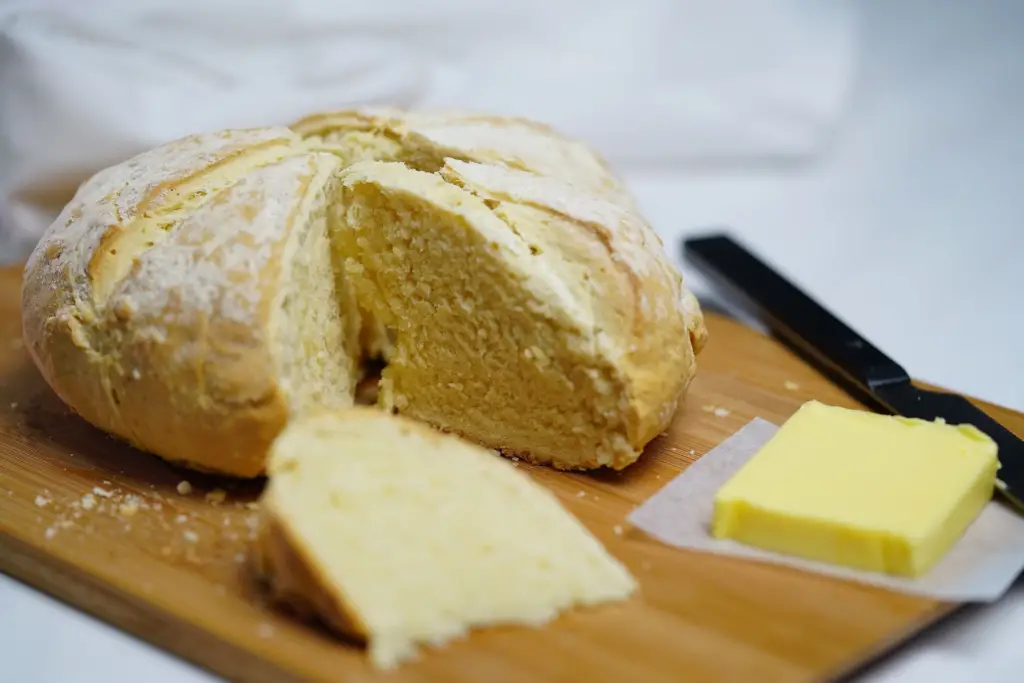
History and Background
Damper is a traditional Australian bread that was originally developed by stockmen who traversed the outback for weeks at a time and needed a sturdy, filling bread that could be made without yeast.
It has since become a staple in Australian households, often served as a starter.
Australian Food – Ingredients for Damper Bread
- 3 cups of self-raising flour
- 1/2 teaspoon of salt
- 3 tablespoons of butter
- 3/4 cup of water
- 1/2 cup of milk
How to prepare Damper Bread
- To make damper bread, sift the flour and salt into a bowl and rub in the butter until the mixture resembles fine breadcrumbs.
- Gradually add water and milk to form a soft dough.
- Knead lightly on a floured surface and shape into a round loaf.
- Bake in a preheated oven at 190°C (375°F) for 30-35 minutes, or until the bread sounds hollow when tapped on the bottom.
Damper is best served warm with butter or as a base for an Aussie-style bruschetta topped with ingredients like avocado, tomato, and shrimp.
Matching Drinks
Damper pairs well with a cold Australian beer or a crisp white wine.
Australian Food – Kangaroo Carpaccio

Australian Cuisine – History and Background
Kangaroo meat has been a part of the Indigenous Australian diet for tens of thousands of years, but kangaroo carpaccio is a contemporary interpretation that utilizes this lean and rich meat in a raw preparation, influenced by Italian cuisine.
Australian Food – Ingredients for Kangaroo Carpaccio
- 200 grams of kangaroo fillet, trimmed and chilled
- 1 tablespoon of extra virgin olive oil
- 1 teaspoon of lemon juice
- Rock salt and cracked black pepper
- 1/2 cup of rocket leaves
- Shaved Parmesan cheese
- Toasted macadamia nuts, crushed
How to prepare Kangaroo Carpaccio
- Thinly slice the chilled kangaroo fillet and arrange the slices on a plate.
- Whisk together olive oil and lemon juice and drizzle over the meat.
- Season with salt and pepper.
- Garnish with rocket leaves, shaved Parmesan, and toasted macadamia nuts.
Kangaroo carpaccio is an elegant and light starter, perfect for a sophisticated dinner party or as an introduction to game meats for the uninitiated.
Matching Drinks
A peppery Shiraz or a bold Cabernet Sauvignon complements the rich flavor of kangaroo meat beautifully.
Australian Food – Grilled Kangaroo

Kangaroo meat is a true Australian specialty, lean and rich in flavor. It’s a dish that showcases Australia’s wild game and is often served at upscale restaurants as well as home barbecues, reflecting the country’s love for the grill.
Australian Cuisine – Ingredients for Grilled Kangaroo
- 4 kangaroo fillets
- 2 tablespoons olive oil
- 2 garlic cloves, crushed
- 1 tablespoon soy sauce
- 1 tablespoon honey
- 1 teaspoon ground coriander
- 1 teaspoon cracked black pepper
- Salt to taste
How to prepare Grilled Kangaroo
- Begin by marinating your kangaroo fillets in a mix of olive oil, crushed garlic, soy sauce, honey, ground coriander, cracked black pepper, and a touch of salt for at least two hours, or overnight for an even deeper flavor.
- Preheat the grill to high. Grill each fillet for 2-3 minutes on each side for medium-rare, depending on thickness.
- Rest the meat for a few minutes before serving to allow the juices to redistribute.
- Present the grilled kangaroo on a warm plate, perhaps over a bed of wild rocket and garnish with a sprinkle of fresh herbs.
- A glass of bold Shiraz from Barossa Valley complements the rich flavors of the kangaroo perfectly.
Australian Food – Barramundi with Lemon Myrtle
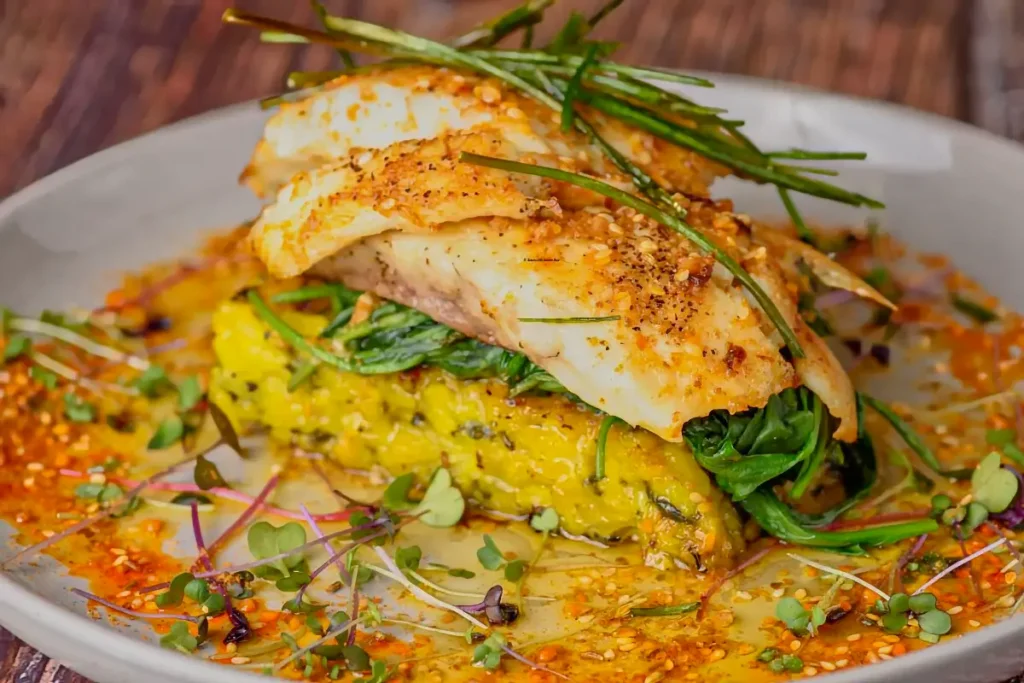
The barramundi is a fish that is synonymous with Australian cuisine. The addition of lemon myrtle – an Australian bush spice with a fresh, lemon-lime flavor – makes this dish sing with Aussie character. It’s a dish often enjoyed in coastal regions, especially during the summer months.
Australian Cuisine – Ingredients for Barramundi with Lemon Myrtle
- 4 barramundi fillets, skin on
- 2 teaspoons ground lemon myrtle
- 1 tablespoon olive oil
- Salt and pepper to taste
- Lemon wedges for serving
How to prepare Barramundi with Lemon Myrtle
- Season the barramundi fillets with salt, pepper, and the ground lemon myrtle.
- Heat olive oil in a pan over medium-high heat.
- Place the fillets skin side down and cook until the skin is crispy, about 3-4 minutes.
- Flip and cook for another 2-3 minutes or until the fish flakes easily with a fork.
- Serve the fish skin side up with fresh lemon wedges on the side.
To serve, place the barramundi on a warm plate, skin side up to showcase the crispiness, with a side of steamed Australian greens like warrigal greens. Pair with a light and crisp Riesling to enhance the lemony notes of the dish.
Australian Food – Australian Meat Pie

The Australian meat pie is an iconic street food and comfort dish, often found at sports events and local bakeries.
It’s the quintessential Aussie lunch on-the-go, but it’s also found at the dinner tables of families enjoying a warm, comforting meal.
Australian Cuisine – Ingredients for Australian Meat Pie
- 500g minced beef
- 1 large onion, finely chopped
- 2 tablespoons all-purpose flour
- 1 tablespoon tomato paste
- 2 cups beef stock
- 1 teaspoon Vegemite or beef extract
- Puff pastry sheets
- 1 egg, beaten
- Salt and pepper to taste
How to prepare Australian Meat Pie
- Cook the minced beef and onion in a pan until the meat is browned and the onion is soft.
- Stir in flour and cook for a minute.
- Add tomato paste, beef stock, and Vegemite, simmering until the mixture thickens.
- Season with salt and pepper.
- Cut puff pastry to line pie tins, fill with the meat mixture, and cover with another layer of pastry.
- Brush with beaten egg and bake at 220°C (428°F) for 15 minutes.
- Reduce heat to 180°C (356°F) and bake for another 25 minutes until golden.
Serve the pie with a dollop of tomato sauce (ketchup) on top, and if you want to go the Aussie way, place it on top of a classic bed of mushy peas.
A dark ale or a full-bodied red wine, like a Cabernet Sauvignon, makes for a perfect accompaniment.
Australian Food – Lamingtons
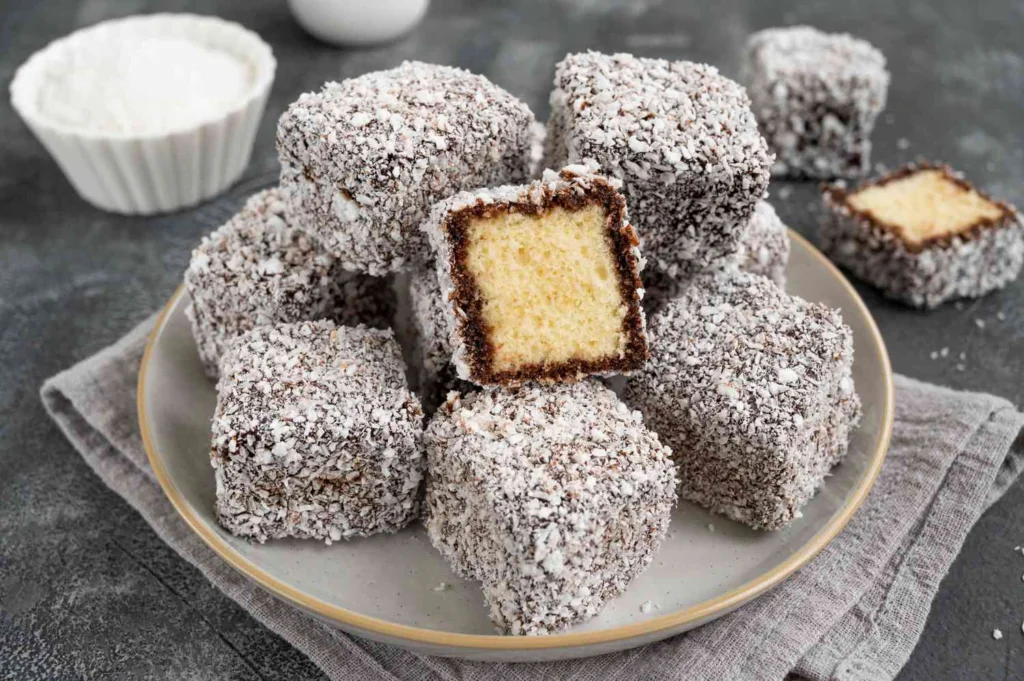
Lamingtons are an Australian classic, named after Lord Lamington, a former Governor of Queensland.
These square-shaped sponge cakes dipped in chocolate and rolled in desiccated coconut are often found at fundraisers known as “lamington drives,” community gatherings, and are a staple in any Australian bakery.
Australian Cuisine – Ingredients for Lamingtons
- 125g butter, softened
- 1 cup caster sugar
- ½ teaspoon vanilla extract
- 3 eggs
- 1¾ cups self-raising flour
- ½ cup milk
- 2 cups icing sugar
- 1/3 cup cocoa powder
- 3 tablespoons boiling water
- 2 cups desiccated coconut
How to prepare Lamingtons
Beat butter, sugar, and vanilla until creamy, then add eggs one at a time. Fold in sifted flour alternately with milk. Pour into a lined pan and bake for 30 minutes at 180°C (356°F).
Cool and cut into squares. Make icing with icing sugar, cocoa, and boiling water, and coat each square, then roll in coconut.
Present the lamingtons piled high on a serving platter, allowing the coconut to be the star. They’re best enjoyed with a cup of strong Australian tea or a coffee.
Australian Food – Pavlova

The pavlova, named after the Russian ballerina Anna Pavlova, is a subject of trans-Tasman rivalry between Australia and New Zealand, with both countries claiming its origin.
Regardless of its beginnings, it’s a celebratory dish, often served during Christmas, festive seasons, and family gatherings.
Australian Cuisine – Ingredients for Pavlova
- 4 egg whites
- 1 cup caster sugar
- 1 teaspoon white vinegar
- 1 teaspoon cornflour
- 1 teaspoon vanilla extract
- 1 cup whipping cream
- Fresh fruits for topping (typically kiwi, strawberries, and passionfruit)
How to Prepare Pavlova
- Whisk egg whites until peaks form.
- Gradually add sugar, then vinegar, corn flour, and vanilla.
- Spread into a circle on a baking tray, forming a crater in the center.
- Bake at 120°C (248°F) for 1.5 hours.
- Whip cream and spread over the cooled meringue.
- Top with fresh fruit.
The pavlova should be presented with elegance, with a generous amount of whipped cream and a vibrant array of fresh fruits on top. Pair it with a sweet dessert wine or a sparkling Moscato.
Conclusion
Exploring Australian cuisine is a journey through flavors and traditions that are as diverse as the landscape itself. From the bush to the ocean, the main courses are a hearty reflection of local produce and multicultural influences, while the puddings tell stories of history, celebration, and community. Whether you’re in for a savory bite of a meat pie or the sweet indulgence of a lamington, Australian dishes are sure to provide a culinary adventure.
FAQ’s
What is a typical Australian barbecue?
A typical Australian barbecue often includes a variety of meats like beef, lamb, and sausages, as well as seafood like prawns and barramundi. It’s accompanied by salads and sides, and it’s a social event as much as a meal.
Are kangaroo dishes common in Australia?
Yes, kangaroo is a common and sustainable meat source in Australia, often enjoyed for its rich flavor and lean quality. It can be found in supermarkets and restaurants across the country.
What are some native Australian ingredients used in their cuisine?
Native Australian ingredients include lemon myrtle, wattleseed, bush tomato, and macadamia nuts. These ingredients are used to create unique flavors in both traditional and contemporary Australian dishes.
How is Vegemite used in Australian cooking?
Vegemite is commonly spread on toast, but it’s also used in cooking to add a savory depth of flavor to dishes like stews, gravies, and even the Australian meat pie.
What is the difference between a lamington and a pavlova?
A lamington is a sponge cake coated in chocolate and coconut, whereas a pavlova is a meringue-based dessert topped with whipped cream and fresh fruits.
Is Australian Food influenced by other cultures?
Absolutely, Australian cuisine is greatly influenced by British, Mediterranean, Asian, and Indigenous Australian cultures, which is reflected in the diversity of its dishes and flavors.
What Is Australia’s National Dish
Australia’s national dish is the meat pie. It is a classic Australian delicacy enjoyed by locals and visitors alike.
What are some must-try Australian dishes?
Apart from the national dish of meat pie, some must-try Australian dishes include Vegemite on toast, Lamingtons, and Anzac biscuits.
What are the key ingredients in the national dish?
The key ingredients in the national dish of Australia, the meat pie, include minced meat, onions, gravy, and a flaky pastry crust.
Are there regional variations of the national dish?
Yes, there are regional variations of the national dish. Different regions in Australia have their own unique twists and flavors when it comes to meat pies.
How is the national dish traditionally prepared?
The national dish is traditionally prepared by filling the pastry with savory minced meat and gravy, then baking it until the crust is golden and flaky.
Are there modern adaptations of the national dish?
Absolutely! Chefs and cooks have experimented with various ingredients and flavors to put their own spin on the national dish, resulting in modern adaptations that cater to different tastes.

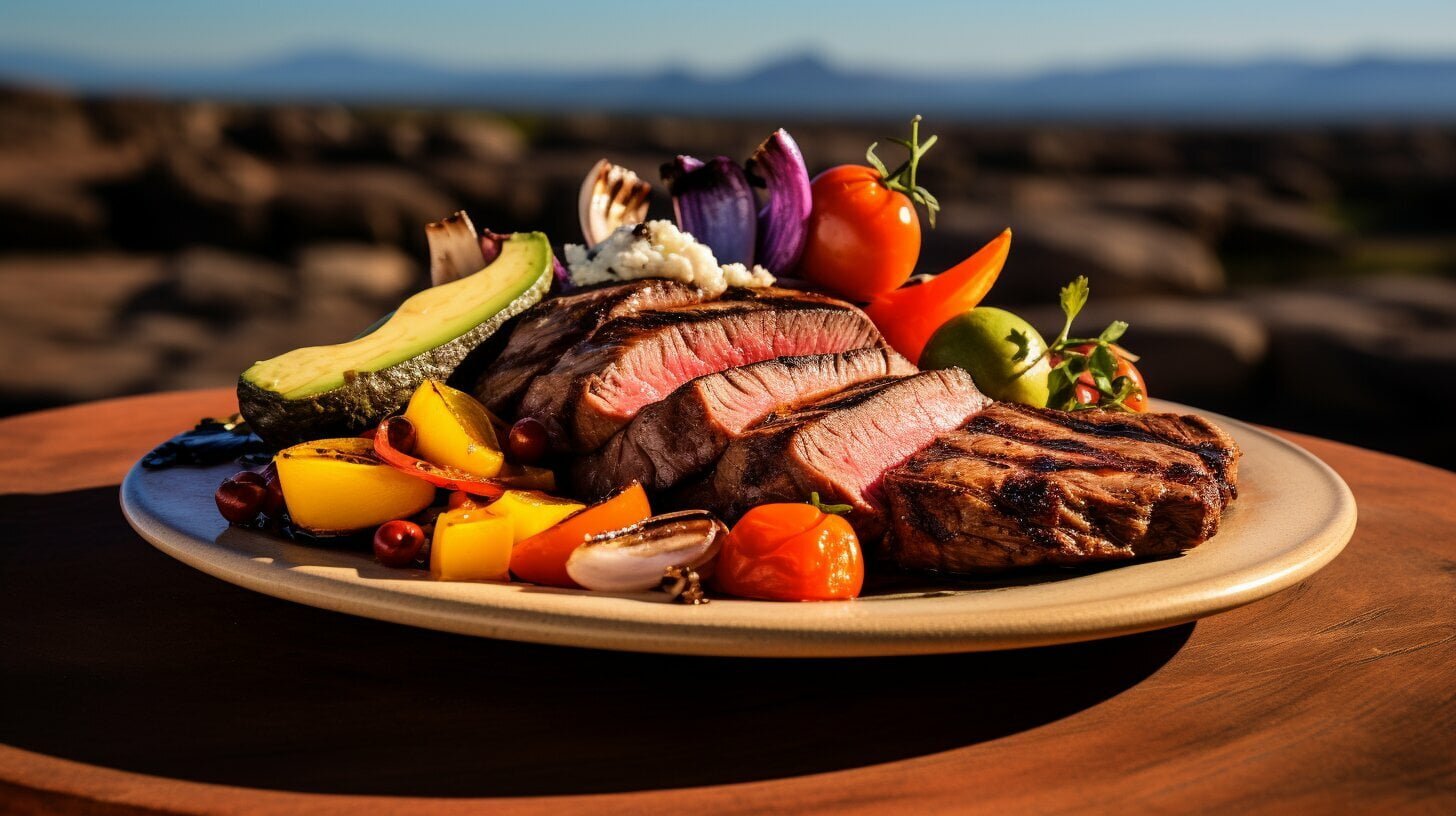
4 thoughts on “Australian Food: 25 Authentic Recipes from Down Under”
Comments are closed.